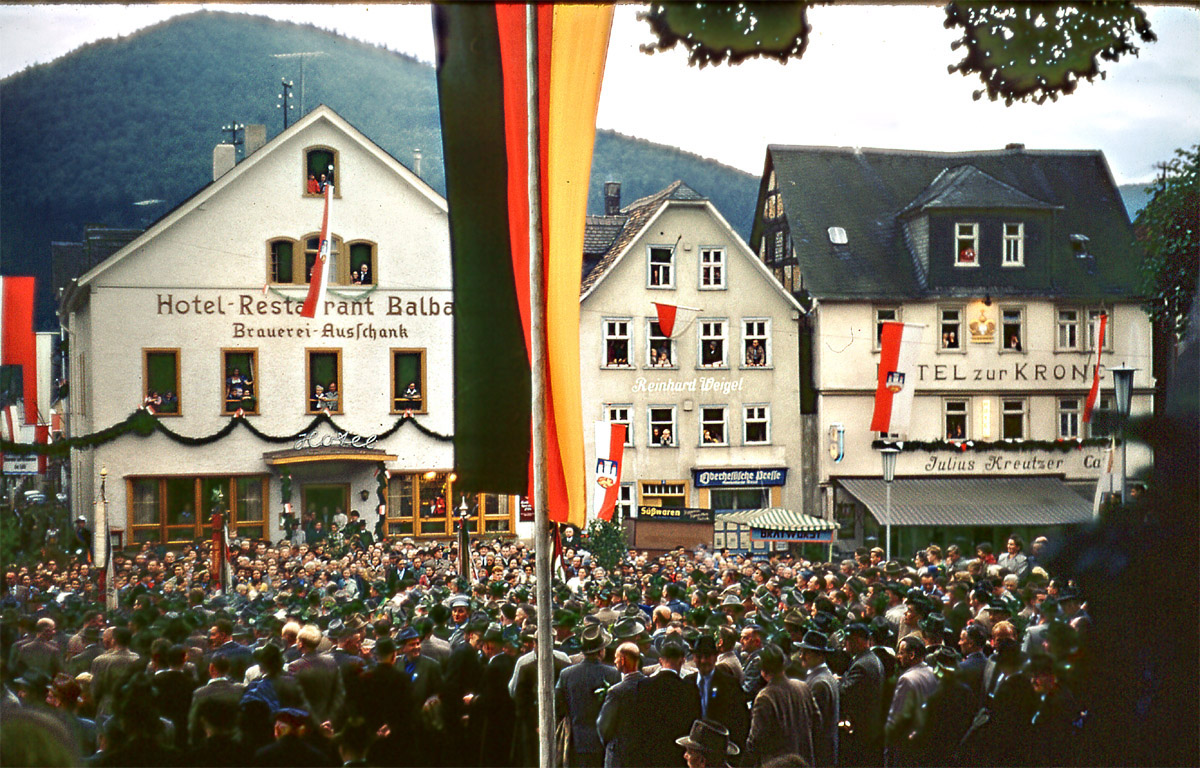The biggest German Volksfest
no one ever heard of,
and the story behind it.
Jerry Nelson, 2016
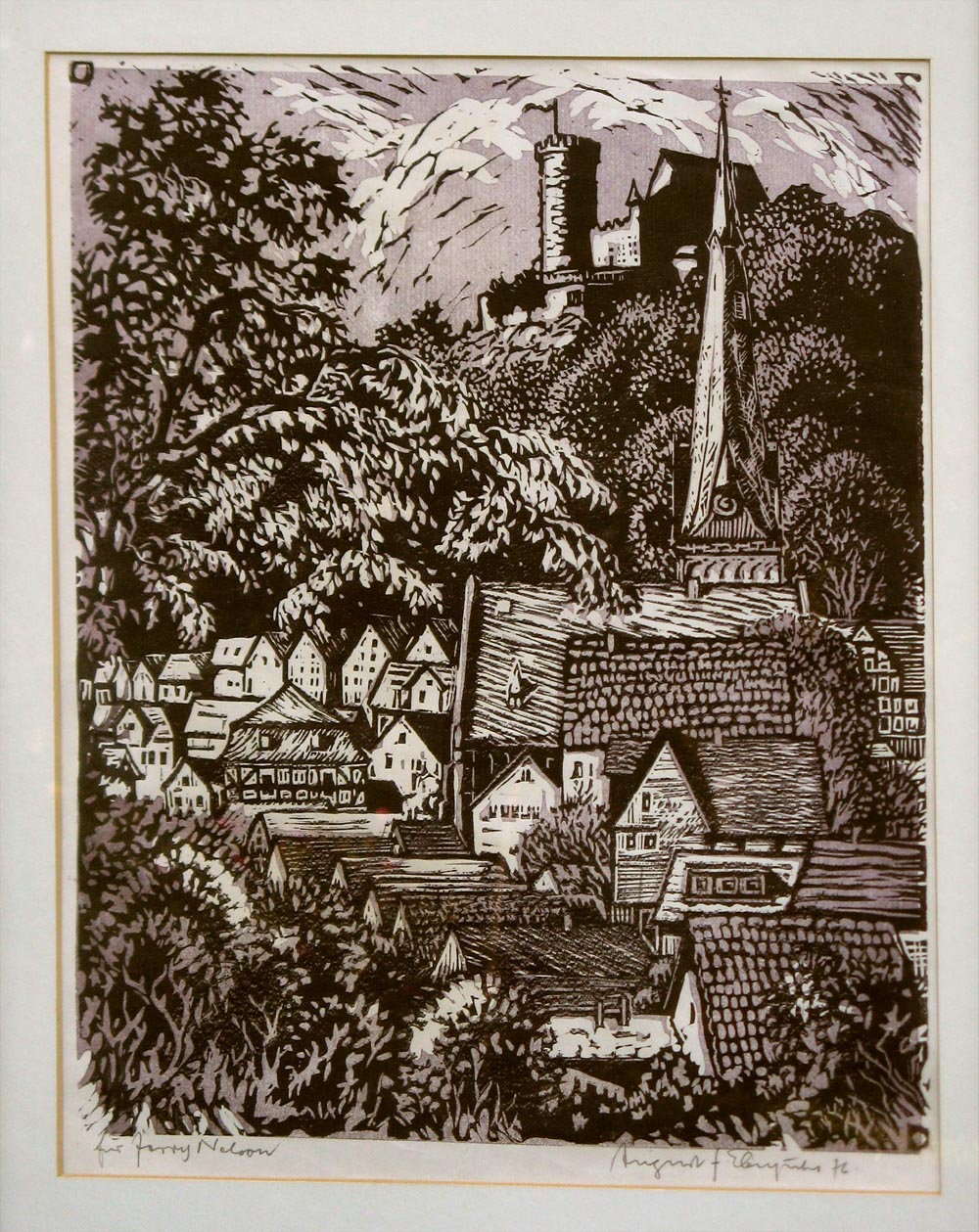
Biedenkopf/Lahn
and its castle, by one
of the town's best-known artists.
August Eberspächer 1976, woodcut 12x16 in,
August Eberspächer 1976, woodcut 12x16 in,
INTRODUCTION
Grenzgang Biedenkopf is the biggest, friendliest German Volksfest you never heard of. Join them once every seven years and do the border rounds ("Grenz" "gang") to make sure the surrounding nobles haven't moved the markers and cheated the Biedenkopf Burgers (citizens, as in "PittsBurg") of their forest lands. Unfortunately, the borders go straight up and down the mountains.
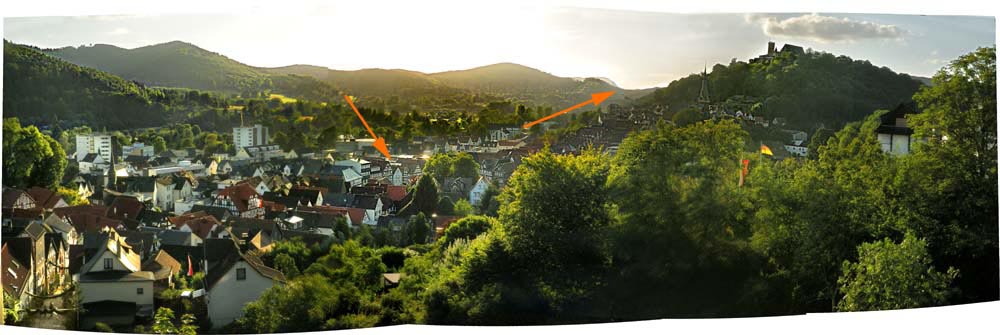
It started two years early for us, when we got reservations for the last rooms left in town at the Park Hotel. After months of training we flew to Germany, checked into our hotel, and surveyed Biedenkopf in the Lahn valley below. It was all there: Fachwerk (open-timbered) houses surrounded a central Marktplatz (marketplace; arrow left), and crooked streets in an Altstadt, the old town, that found their jumbled way up to a castle on the hill. But we weren't here to storm the castle. Our job was to defend the forest -- check every marker and show grass-roots unity against any midnight cowboy moves by surrounding noblemen. Grass-roots unity means thousands marching out with us at dawn, and we would all have to go straight up the hills and back down to the next one. We watched the sun set over an awful lot of hills.
Here are my pictures of Biedenkopf's Grenzgang 2012, a civic festival (Volksfest) I had participated in as a child in 1956, and came back with Robin to do One More Time. I will be 76 in 2019, so "one more time" may be the last time for us. But to start at the beginning -- this is not Disney Castleland and this is not a bierfest.
THE MIDDLE CLASS SAYS "NO" TO THE MIDDLE AGES
( bottom & contents )
In a culture of landed aristocracy, how did ordinary townspeople ever come to have anything to defend?
When people can't make Things, money comes from agriculture. In the Middle Ages, manorialism ("the Lord of the Manor") organized peasants into villages whose residents owed rent and labor services to the nobles. A freeman who owed more than he could pay became a serf. Feudalism added a military class of knights. Lower-status nobles owed military service to their overlords, in return for land and the right to exploit the agricultural underlings who lived there. Rents were collected, mercenaries were hired to sally forth, and defensive walls against all this Medieval silliness went up around neighboring towns who didn't want to be part of the game.
What the wonderful wars of the new military class could not accomplish was completed by the Black Death. About one-third of the European continent's population died in the the plague from 1347 to 1350. But the military class did make a contribution: soldiers' movements spread fleas harboring plague bacteria across Europe.
Town dwellers slowly invented tools, recipes, ways of making things . . . and banded together across towns into guilds, to protect and pass on trade secrets, and propel trade itself. The productive innovations of guilds of craftsmen produced accumulating wealth, and the bourgs of Central and Western Europe developed into cities dedicated to commerce and home to a rising bourgeoisie.
When the new middle class was still weak, the protective power of guilds was important for resisting the extortions of local feudal landlords. Units of political organization soon loomed ahead of guilds busy protecting the trade and trade secrets of skilled craftsmen. Small monarchies arose as the bourgeoisie supported a distant king or queen to suppress their own local royalty -- the hated lords of the manorhouse.
By the late 1500s and early 1600s, the bourgeoisies of England and the Netherlands had become the financial and thus political force that deposed the feudal order. It was a time when many German towns celebrated their commercial power with the construction of a Marktplatz ("market" "plaza" or place). In the Marktplatz, wealthy multi-story open-timbered "Fachwerk" houses took up any space not given over to ornate guild halls, wool and banking exchanges, and everyone's symbol of self-governance, the Rathaus or town hall.
Biedenkopf didn't get very far after entering written history in 1254. It built a castle (only 700 years old, unless you dig deeper on the north side), but, always and first, Biedenkopf tried to protect its large holding of forest lands. The Grenzgang -- "going the Grenze" or border -- was first mentioned in 1693 for protection of border markers. A stone can mark a border, but only a piece of paper can freeze its location and ownership. Slowly, Europe compiled a "kataster" or "cadastre", a combination geological survey, deed register and & title authority, so midnight marker moves by the noblemen's nefarious flunkies weren't worth it anymore. Keeping up with the trend, Biedenkopf replaced the piles of rocks, marked trees, and wooden posts with stone boundary markers in 1777, and the Grenzgang became largely ceremonial. But the idea that you could keep what you had was not yet settled.
FINALLY & COMPLETELY: THE WOODS ARE OURS
( bottom & contents )
The borders to be marched took their final form only in 1832. The Großherzogliche Oberforst-Sekretär Hoffmann (the Forestry Chief Secretary of the Grand Duchy [of Hesse]) had to sit down with the lowly Gemeinde (county) of Biedenkopf to "clarify" (reduce) the Gemeinde's forest holdings, document the agreement, and submit the document for full and final ratification by Land Hessen -- at that time, an independent country still nearly 40 years away from statehood in the belated emergence of the German nation. Properly clarified, the town's forest lands shrunk by about one-third, but Biedenkopf won complete administrative control of its forest lands, and the borders marched in celebration for "Grenzgang 1839" are the same borders we march today.
---Hinterländer Anzeige Sondernummer, 15 August 1956, page 5.
Victory at last? The upper classes sniffed.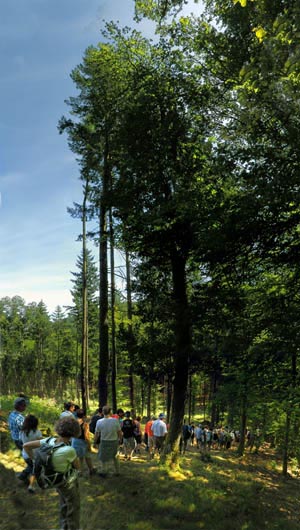
FÖRSTER OPPOSES GRENZGÄNGER TRAMPLING THE WOODS. The landed aristocracy -- the Prussian Junkers and House of Hohenzollern up north, the Grand Duchy of Hesse (Großherzogtum Hessen) down here -- they all had their vast estates and meaningless hunting rituals, but looked with disdain when citizens came up with their own holidays, like going out to hunt border markers without horses.
Still, there were times on steep and stony paths when we thought of the Großherzoglich Hessische Revierförster von Zangen -- the Grand Duke of Hesse's District Forrester for Biedenkopf -- had a point when he opposed the Grenzgangs of 1848, 1857 and 1864: . . .
that it is namely a huge, purposeless act of punishing drudgery,
to run around 3 days long on the arduous borders of Biedenkopf --
and then on top of that, to call this a pleasure --
that is something we indeed appreciated long ago,
that this imaginary pleasure is so deeply rooted in Biedenkopf,
that one might as well not oppose it.
"... daß es nämlich gweiß eine große und zwecklose Strappazze ist, 3 Tage lang
an den so beschwerlichen Grenzen der Biedenkopfer Gemarkung herumzulaufen und
dieß noch obendrien ein Vergnügen zu nennen, so haben wir doch damals schon
eingesehen [understood, appreciated, accepted], daß dieß einbegildete Vergnügen
so tief eingewurzelt in Biedenkopf ist, daß man ihm nicht entgegentreten soll."
--Hinterländer Anzeige - Sondernummer 15 August 1956, page 3
The Grand Duke resigned himself to the imperturbable commitment of the town's citizens to hold the festival, but, by 1879, festivities were canceled by the town's own political leaders "for lack of interest".
FINANCIAL BUBBLE, SPECULATIVE WEALTH, BETTER THINGS TO DO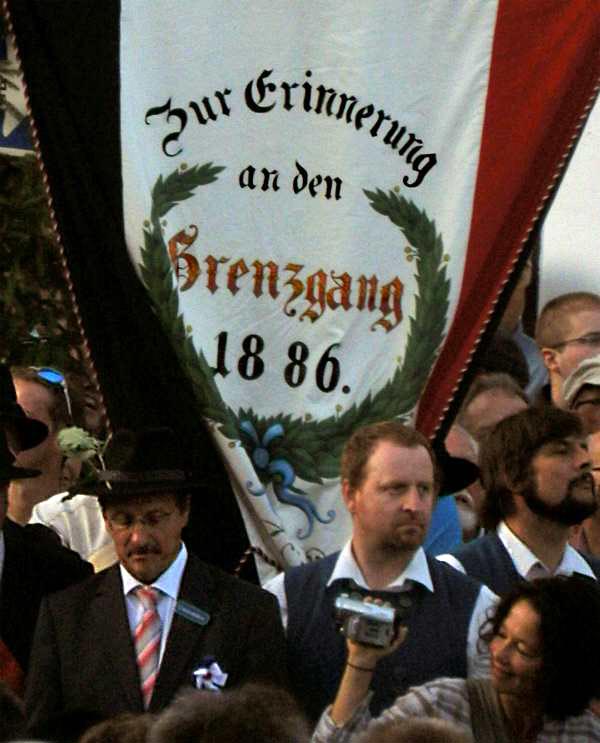
( bottom & contents )
The Grenzgang faltered in 1879.
As victors in the Franco-Prussian war of 1870-71, Germany got the spoils: five billion French gold franks, which Germany melted and re-cast as billions of Goldmarks. Biedenkopf's mayor and town council looked wistfully at the speculative boom in railroad construction, which led to a boom in coal and steel industrialization -- and an 1873 financial collapse that depressed the economy into the 1890s. The mayor announced a vote of zero funds for Grenzgang. Citizens! Seize tomorrow, get rich! People wanted tomorrow, not festivals celebrating a bygone past. Germans turned away from small rural towns with forests, agriculture, silly folk customs, and no industry. For a 20th century parallel, see Robert Putnam's "Bowling Alone" and his portrait of Americans who no longer value civic engagement or regard relationships with neighbors as worthwhile. There was no Grenzgang 1879.
The citizens still wanted Grenzgang even if their government didn't. They formed their own committee (Grenzgangs-Komitee, 1881), collected over half the funds needed, stacked the town council with two elected members from their organization, and staged the 1879+7=1886 Grenzgang with minimal town funding.
Even the mayor was swept away by the enthusiasm and success of the restored celebration, and the entire town is unstoppable today.
All of Europe went through the transitions from manorialism and feudalism to guilds, bourgeoisie towns and small nations-to-be. Perhaps half a dozen towns hold similar festivals, but the Biedenkopf Grenzgang is probably the largest. Our job: get through it alive.
BREAKFAST
( bottom & contents )
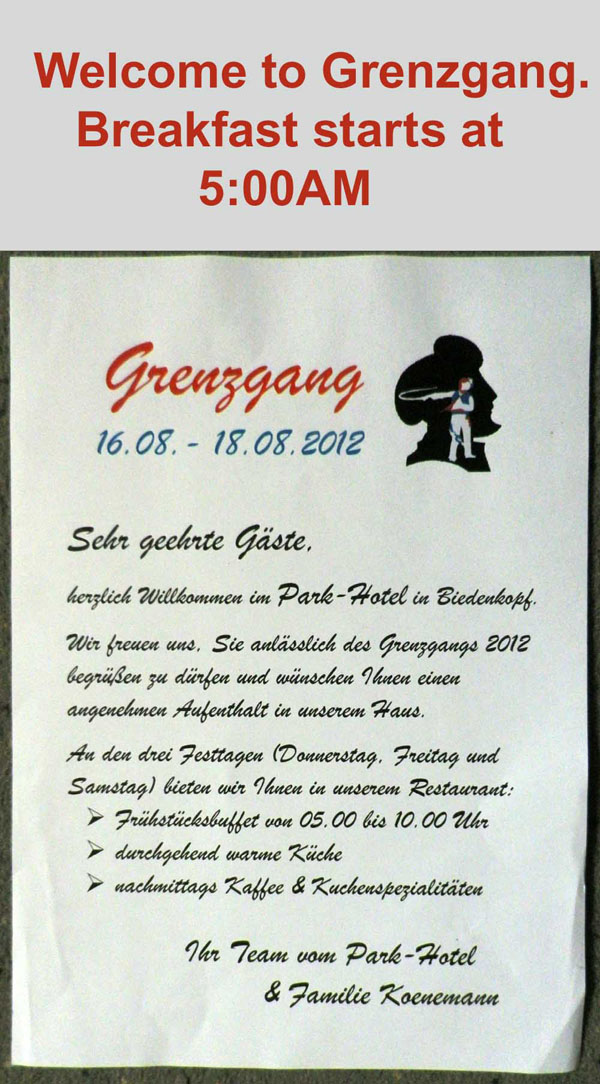
If you're already late by 6:30AM, are you sure you want to do this?
OK, click on the photo, you'll feel better.
KOMMERS
( bottom & contents )
The town was thrown open to all guests on Wednesday, before marching began the next morning.
a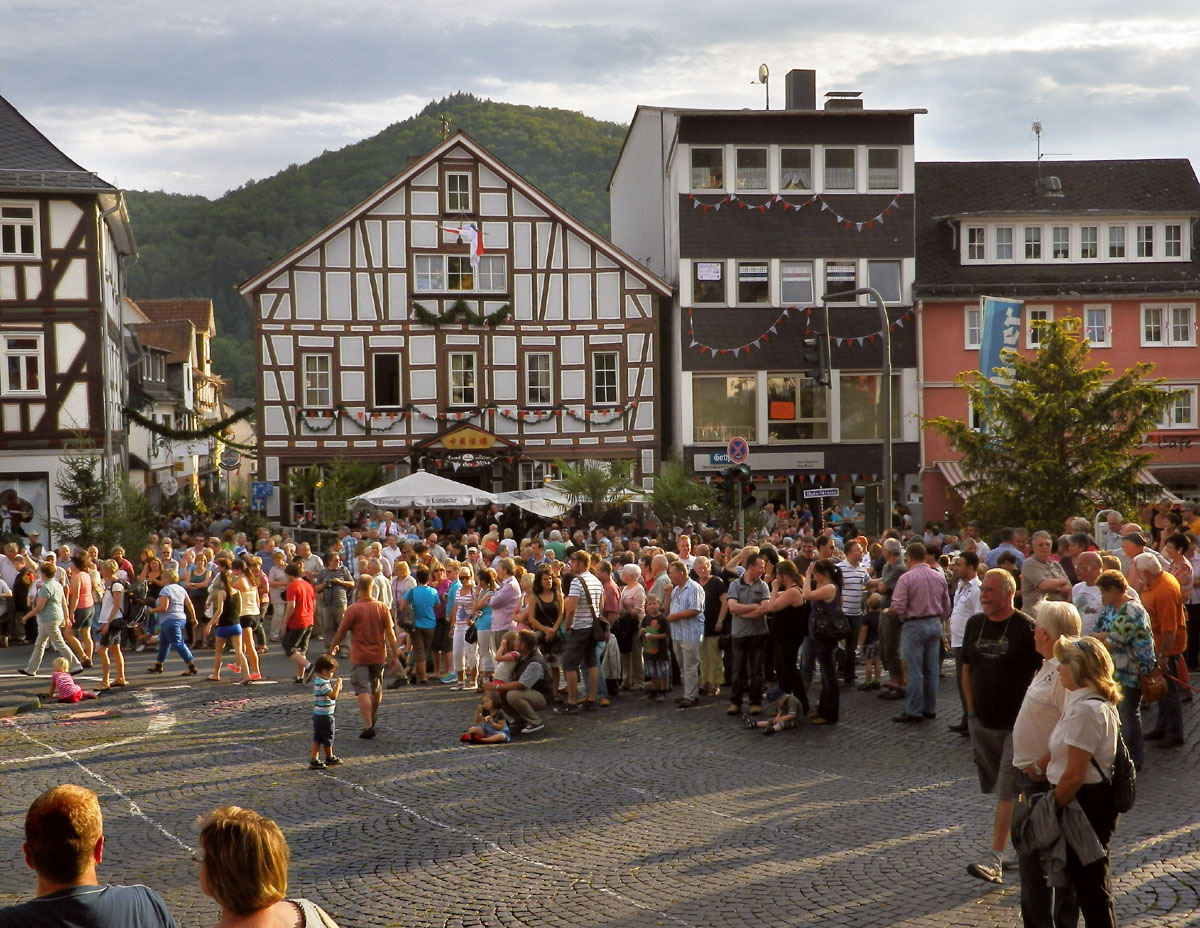
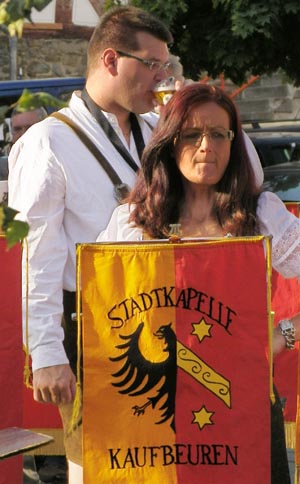
Every street leads to a different neighborhood, a different street party . . . a crowded alley, beer benches wall-to-wall, a band.
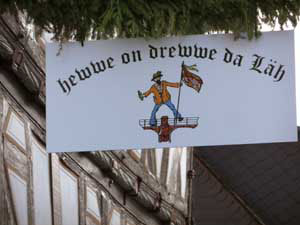 Here in town, only my childhood
friend Hartmut Eberspächer is left. On childhood vacations living with
his family, we were "Hewwe on drewwe da Läh" --
outside of the old town, "in and around the Lahn" or "rueber und
drueber der Lahn" in proper German. So I found the gathering for that
neighborhood and sat down next to a stranger. Eventually I pulled
out my Dad's photos, the 1956 Grenzgang -- the airport taxi had been in
the driveway as the last sheet came off the printer, but I was here now
and goddammit I had them all.
Here in town, only my childhood
friend Hartmut Eberspächer is left. On childhood vacations living with
his family, we were "Hewwe on drewwe da Läh" --
outside of the old town, "in and around the Lahn" or "rueber und
drueber der Lahn" in proper German. So I found the gathering for that
neighborhood and sat down next to a stranger. Eventually I pulled
out my Dad's photos, the 1956 Grenzgang -- the airport taxi had been in
the driveway as the last sheet came off the printer, but I was here now
and goddammit I had them all.
It's a big weekend, the biggest in seven years. Noisy people were having a beer with close neighbors, with out-of-town family that made it back. A stranger (me), probably with a terrible foreign accent, sits down in the middle of all this and rummages around for photos from half a century ago. The man I sat down with immediately labels the people on one photo and says "Over there, try him, he probably knows more." "Yes," the next guy says, adding a name. "For a long time she ran a store on the Marktplatz."
I'm a city boy. Are all rural towns are like this? Maybe you could you do this anywhere in the US -- sit down with prints of Dad's 50+ year old slides of the county fair, find anyone who looks old, and she/he will start to label all the people.
Should I find the owner who ran the store on the Marktplatz? I could send her her own copy of the photo after I get home.
"Where can I find the Marktplatz store owner?"
"She died a week before Grenzgang."
ALL LINED UP
( bottom & contents )
Here's the plan. If the mayor can get everyone in town out of bed and lined up on the Marktplatz, then he and his deputies can march out of town with enough citizens behind them to deter anyone from pressuring the town into selling out the forest ("Stadtwald") or, in the old days, deter anyone from just moving the markers in the night and taking it.
You might sleep through a cannon blast from the castle on the hill, but half a dozen of the best marching bands in Germany and Austria are already in uniform and waiting for that signal, and you can wave your warm, soft bed goodbye.
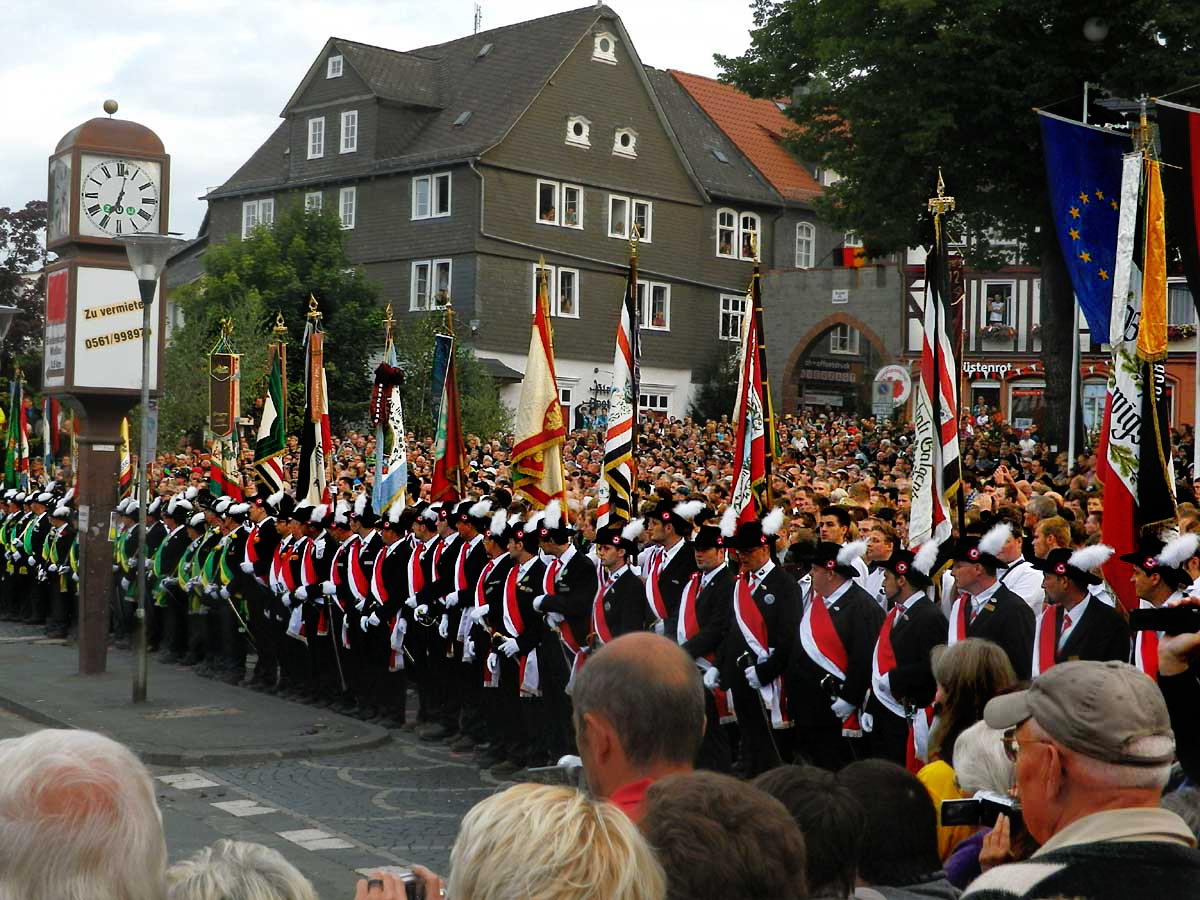
6AM to 7 or 7:30 is the pageantry, the misery comes later.
The pageant winds them all up into the configuration of the photo, 19 neighborhood civic clubs lined up in front of the mayor, and then the pageant unwinds them, one at a time, to march out of town.
But that's an oversimplification.
Each of the 19 neighborhood groups whose front man you see above has its flag carrier and uniformed leaders followed by 10 or 20 other officials, and then all the members. To lead such a unit into place in proper style, most have a horse and rider, and many have a marching band.
It's all here, it looks great, why not just parade around some more?
So we march the whole assembly -- band at full volume, a horse or two, flag-carrier, uniformed officials and members -- into town, around the Marktplatz, out and back again on another street, so that everyone can get a look at them before they line up in their assigned slot, #1 to #19. All 19 paraded and lined up? After presenting arms and manpower count to the Mayor for approval, each of the 19 units peels off in turn to head out of the Marktplatz for good, and out into the woods. Of course, you have to leave town in style, marching band, horse and rider, flag and officials, neighborhood club members, down the street and away, each band playing what it wants until the officials are all gone and a thousand ordinary citizens (Robin and me!) can follow.
Exhausted? Sorry. You've only made it through the formalities.
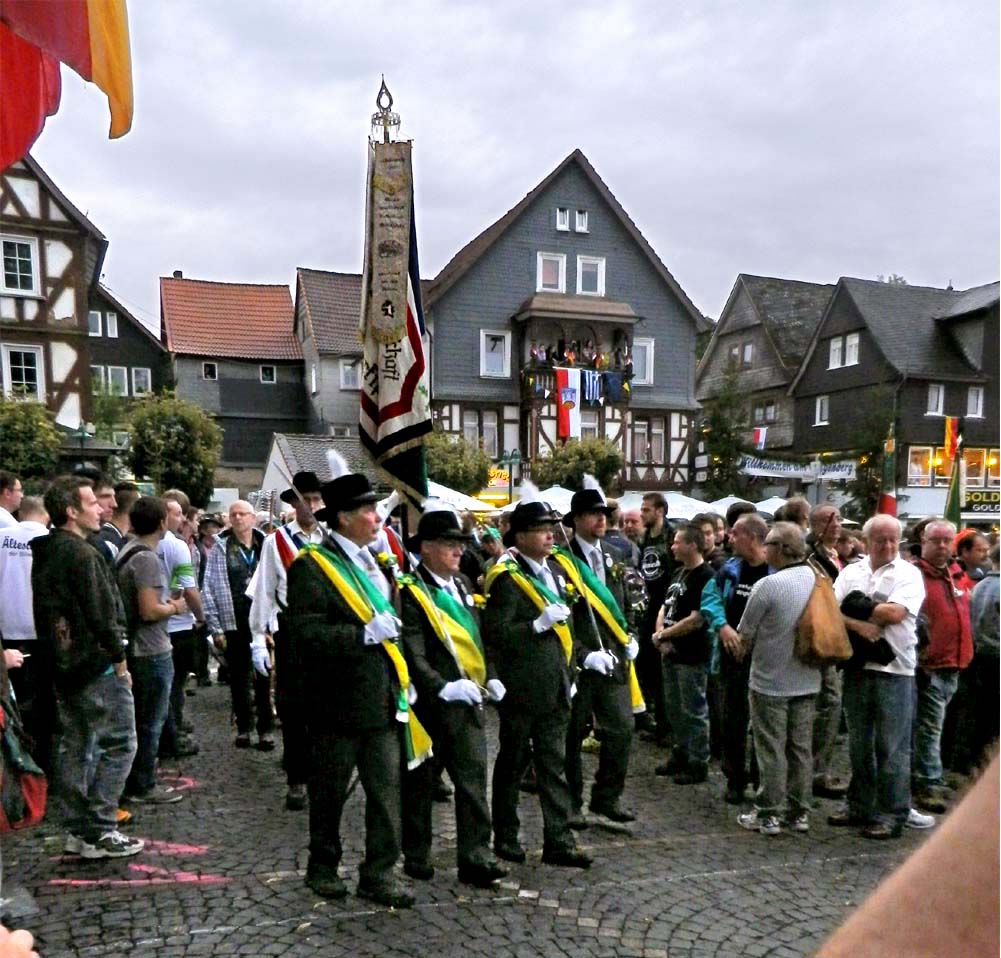
SMILES EVERYWHERE ( bottom & contents )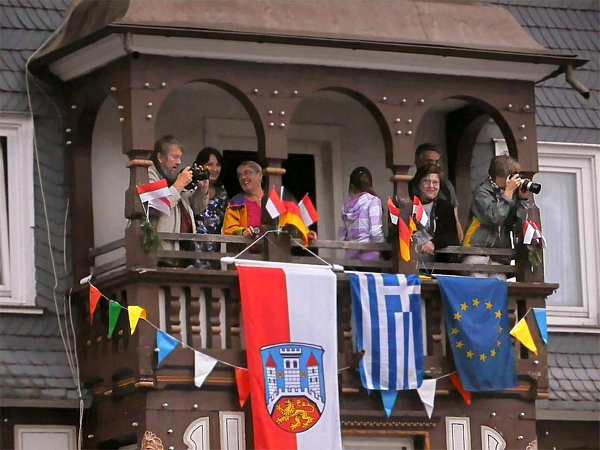
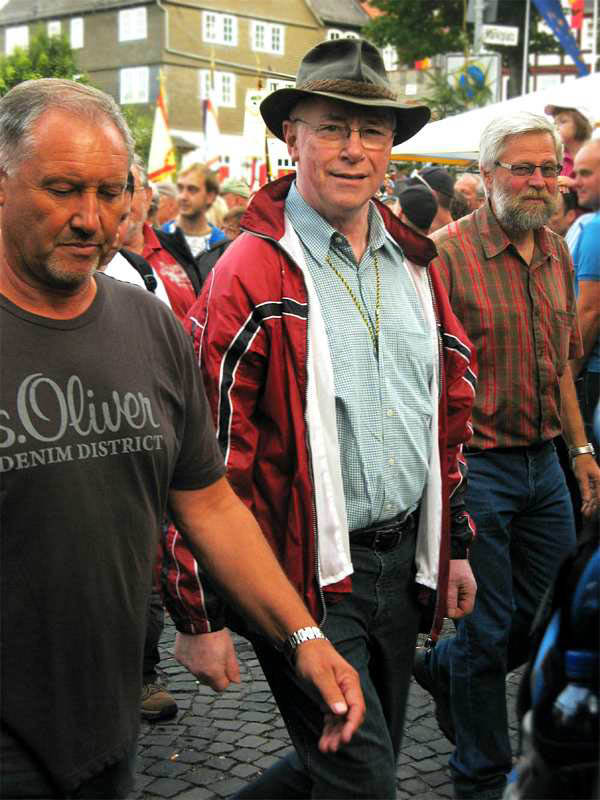
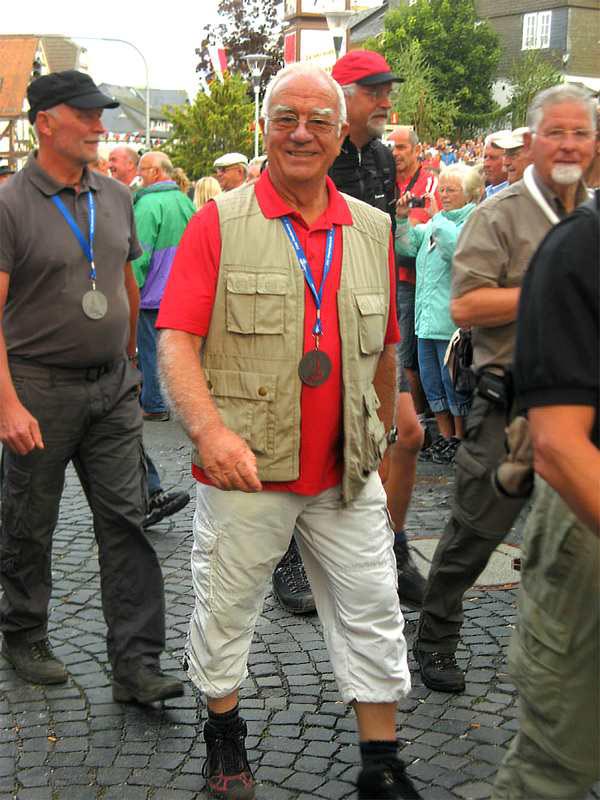
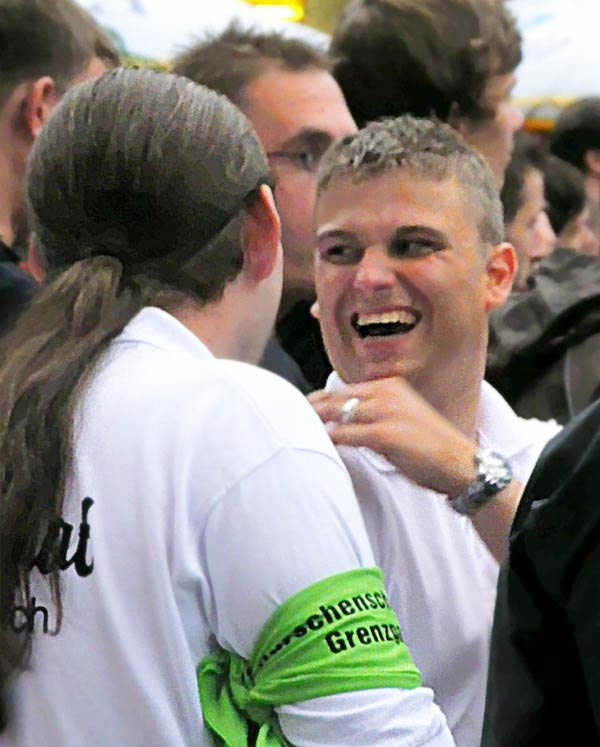
I have done candid photography all my life, but this was too easy -- wherever you turned the camera, there were smiling faces. Above, the "Council of Elders" ("Altestenrat", according to all their T-shirts) gather for consultations.
WETTLÄUFER & MOOR - GRENZGANG'S TOP SYMBOLIC FIGURES
( bottom & contents )
The Wettläufer or racing messengers (literally "competitive runners") signal the crowd and drive the Grenzgang with cracking bull whips. From all the young men's neighborhood-based fraternities -- the horsemen and officers, the flag-bearers and all non-officer members behind them -- the two Wettläufer positions carry the highest honor.
A bull whip cracks because the wave of energy traveling down the whip accelerates the final tip (thinner, less mass, greater acceleration) to supersonic speeds -- it may not be as big as the supersonic boom of a fighter jet, but it's the same idea. After four months of athletic training you should not be surprised to see these two guys everywhere, at energy levels someone my age finds discouraging.
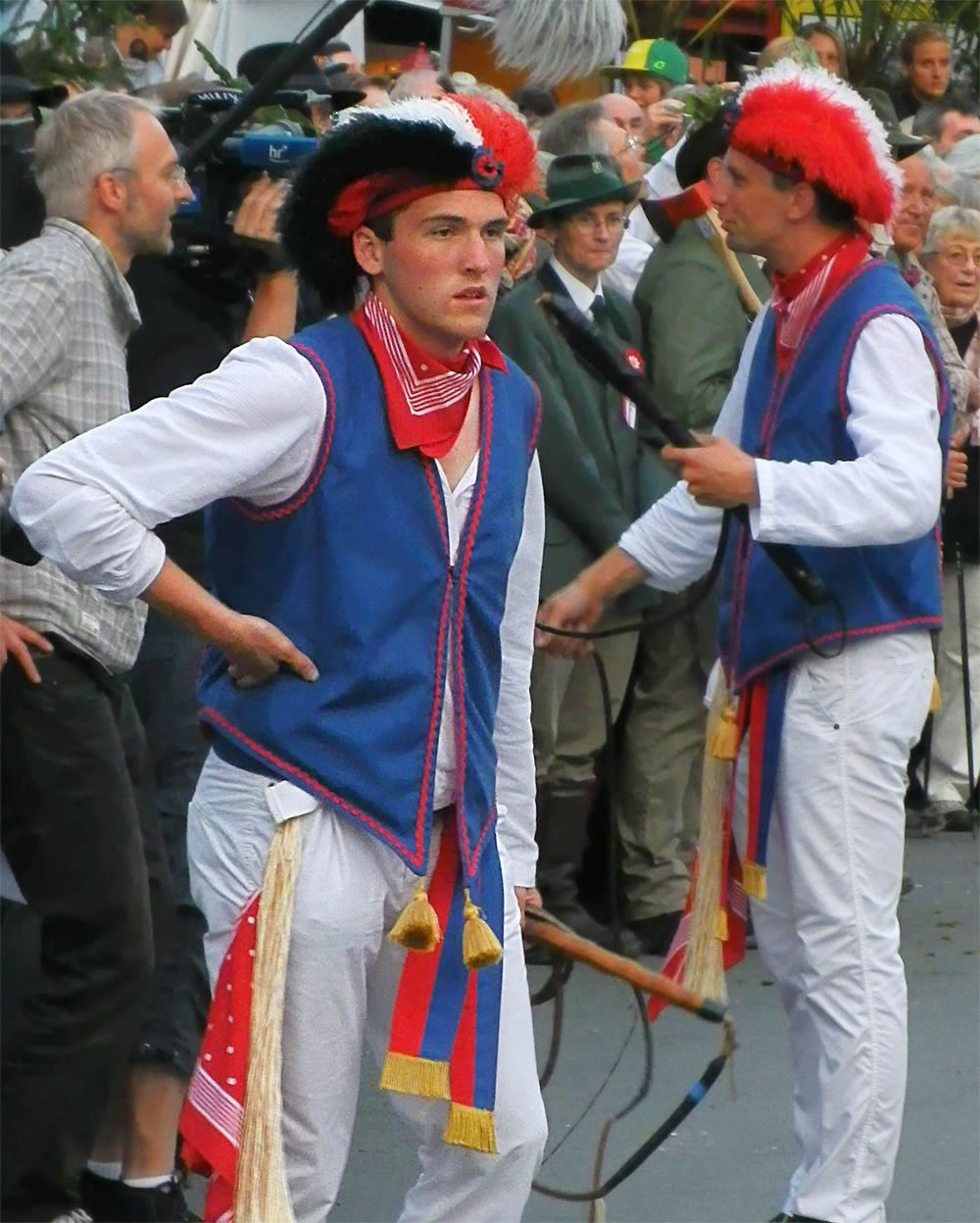
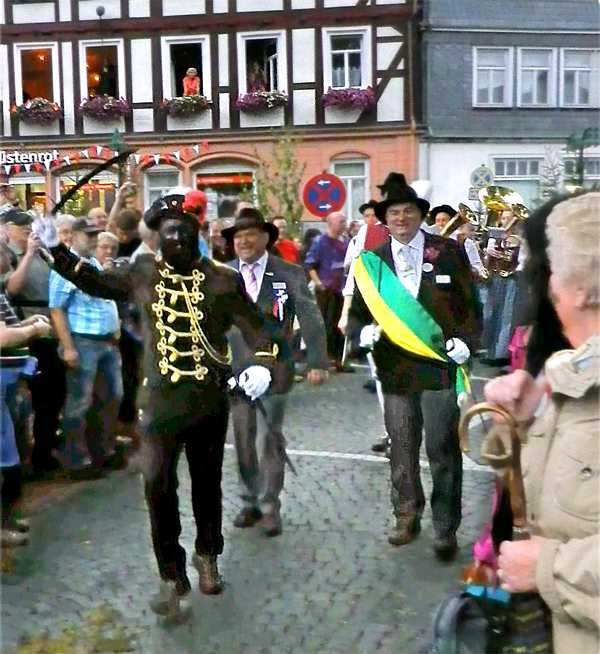
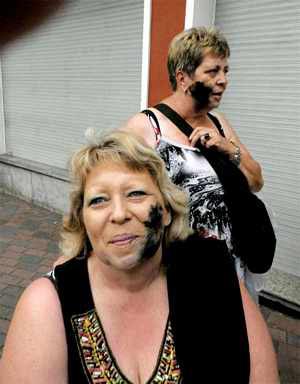
Two women show the black cheeks of anyone kissed by the Moor.
The Moor's blackface is meant to be North African brown, not Negro black. The probability that no Moor ever lived in Biedenkopf only makes him more exotic. Moors are the ultimate symbol of the exotic from the High Middle Ages. Moorish culture reached the wealthy and worldly of that time. Bedroom walls in Burg Eltz, which evolved to its present form in the 1200s and 1300s, were hand-painted with Moorish arabesques. Black-faced Moors made it to the heraldic shields of royal families everywhere, and, by the Renaissance (late 1400s), "we three kings of Orient are [bearing gifts to the Christ child]." On church altar pieces everywhere, in nativity story panels, you are likely to find a dark-faced Moor. Is it racist? Do you want Homer Simpson instead?
Martin Werner never walks anywhere. He executes a forward-and-back dance step for a short distance, pivots one way to see and be seen by everyone while twirling his sword over his head the other way, then dances onward, looking for fun, and for the next woman. Any female caught at the front of surging crowds when the Moor goes by will likely bear evidence of his "Kuss" (kiss).
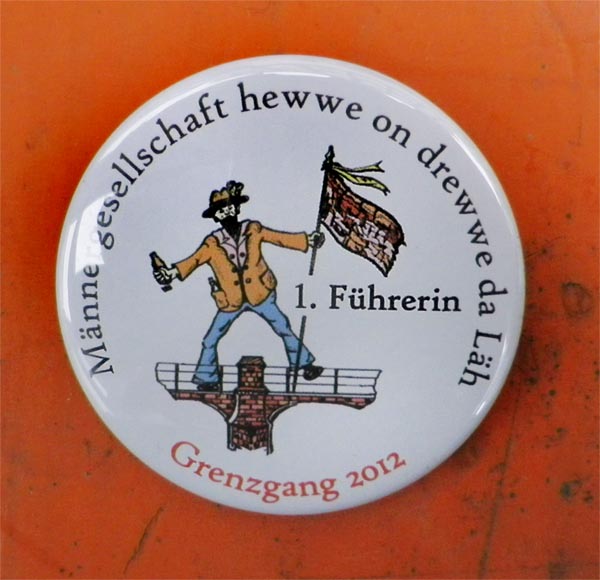
OUT OF THE MARKTPLATZ, THE MARCH HAS BEGUN
( bottom & contents )
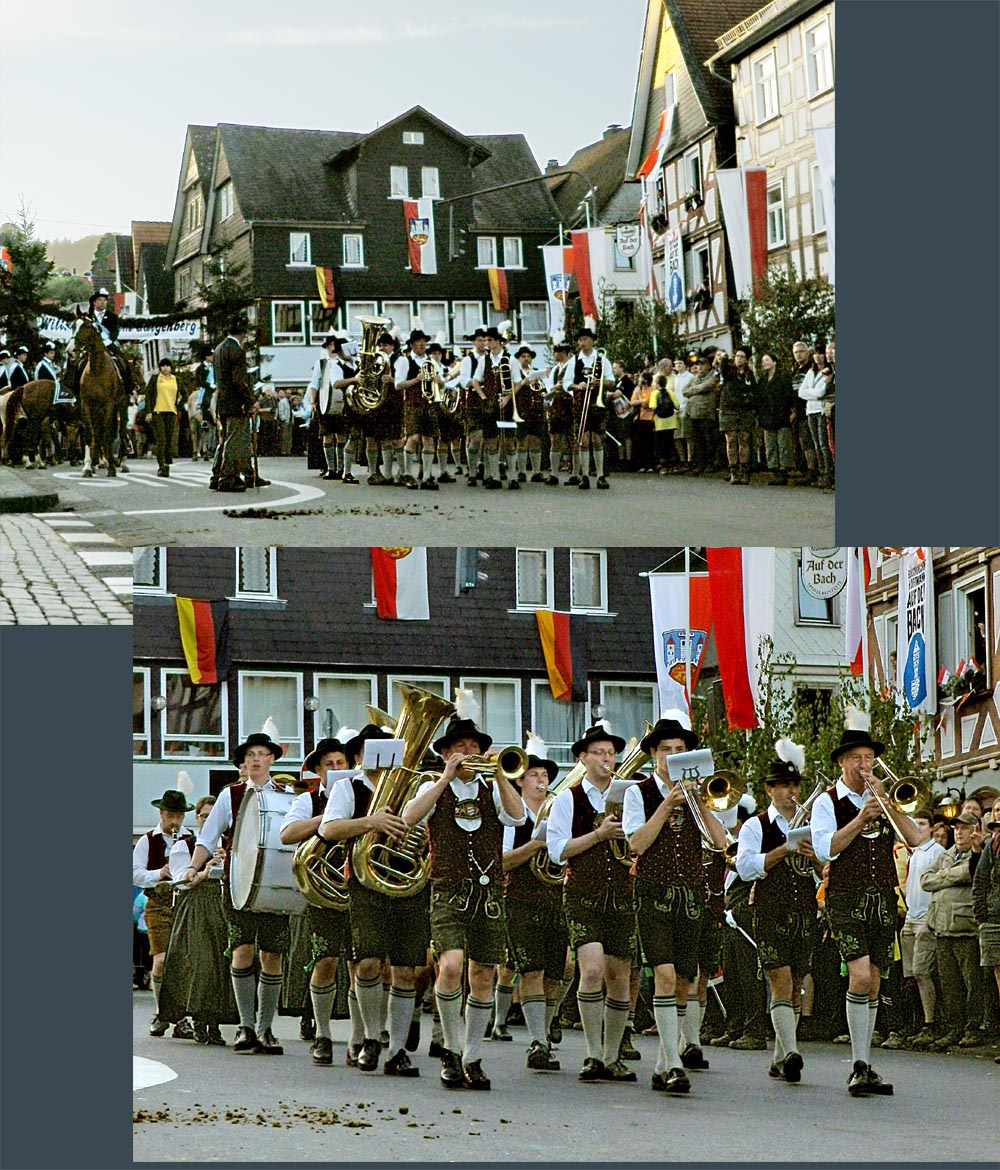
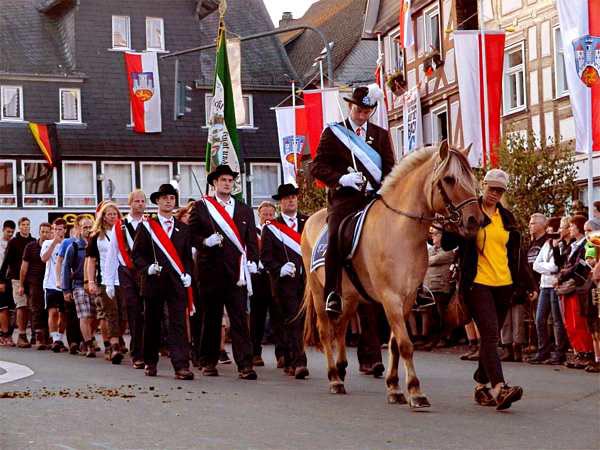
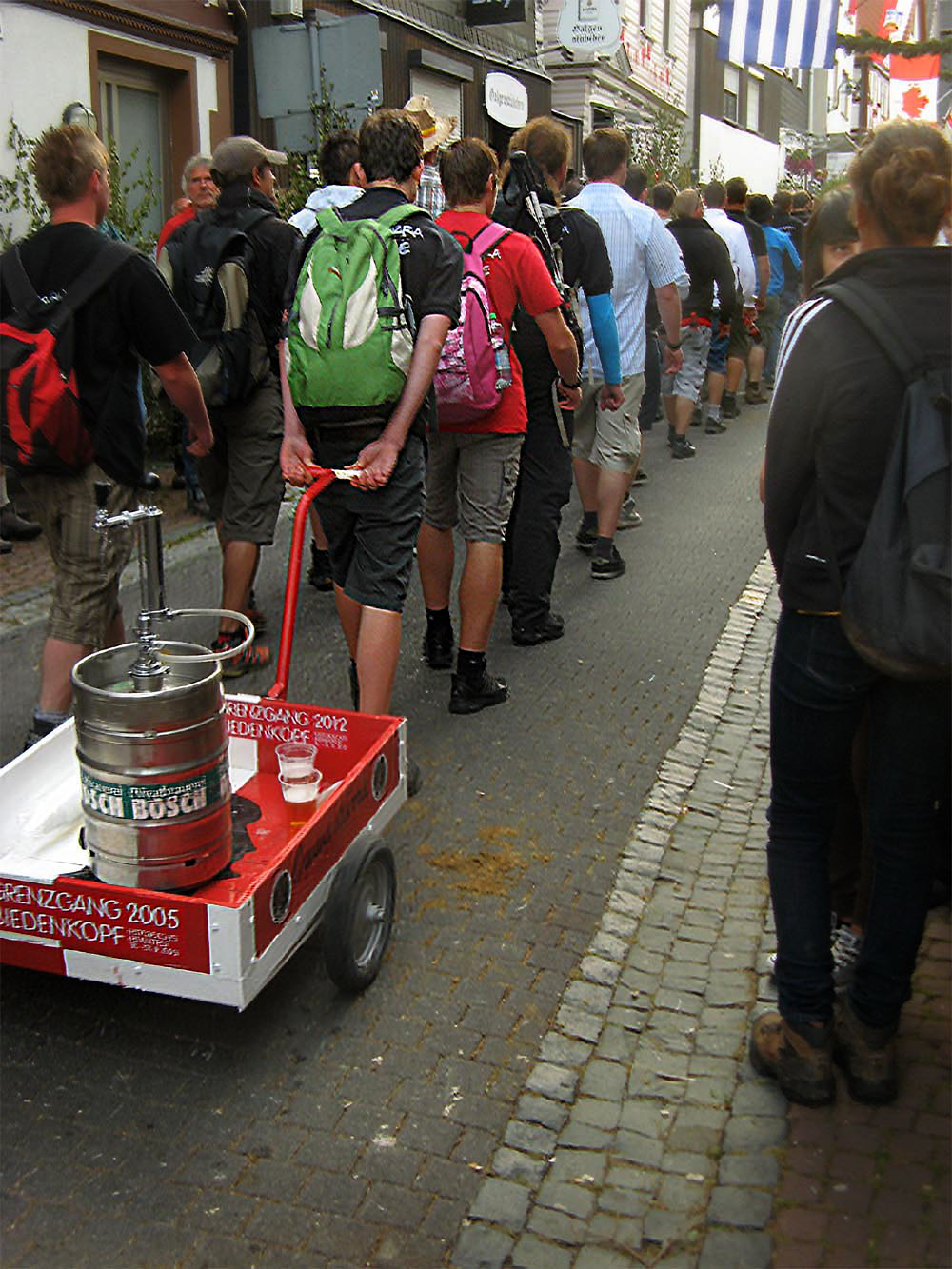
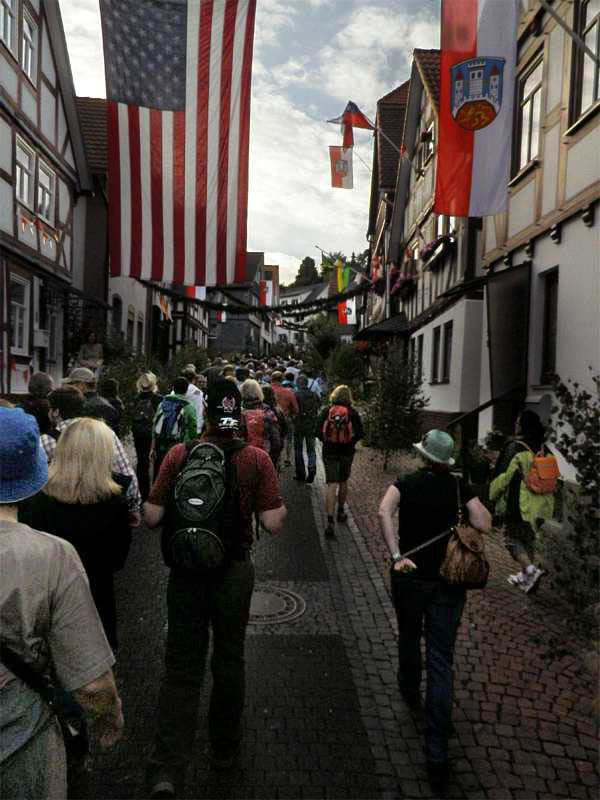
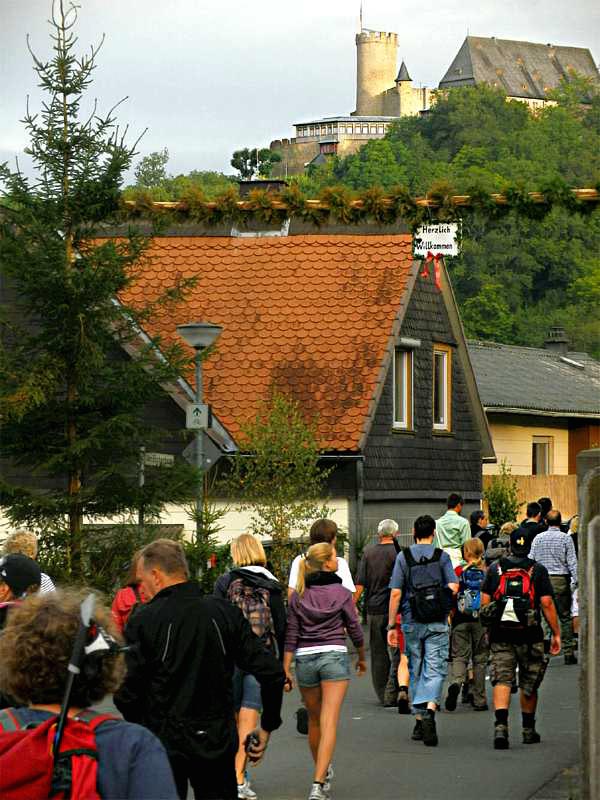
BEHIND THE SCENES: HORSE CARE AND GRENZGANG ORGANIZATION
( bottom & contents )
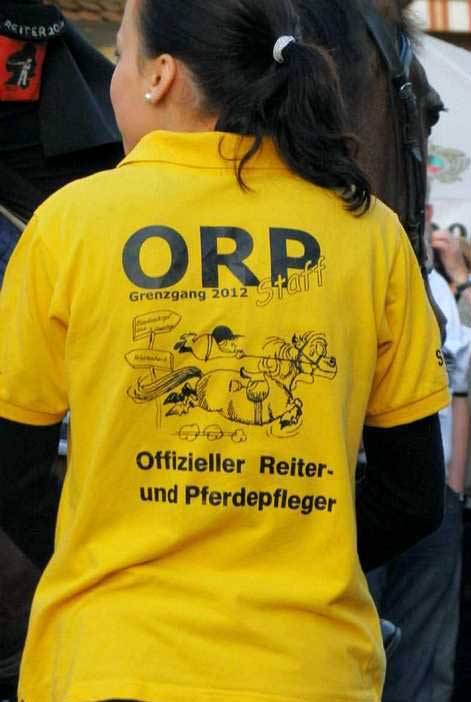
Two Wettläufer are cracking whips -- not any horse's favorite sound -- while full-tilt marching bands play and on-lookers crowd in close enough to get kicked. This is not a rent-a-horse situation.
The riders practice at least every weekend for several months, but the key persons are not the riders. They are the ones wearing the yellow "ORP" T-shirts. After several months of general training, each has been with her/his particular horse non-stop for the past 4 weeks. I am not saying the riders were not in control, but, more than once, I saw the horse itself check to see where its ORP person was and get that "I'm here" touch. (ORP: Offizieller Reiter- und Pferdepfleger -- Official Horseman and Horse Caretaker.)
The heads of the Männergesellschaften and Burschengesellshaften that march out of the town square in full uniform complete the whole march that way, and -- especially on the last day -- may be joined by horses and one of the bands for the triumphal march back into town from the Frühstücksplatz (breakfast break meadow). The Frühstücksplatz can be bedlam (how many thousand people, how many simultaneously playing bands?), but a little way off in the woods, where it is still quiet, the ORPs are with their horses in a quiet corral with food and water.
Assembling on Day One, the alleys were narrow, the cobblestones, wet from overnight rain. Struggling to get up, one fallen horse cut a leg on a front-yard fence and lost liters of blood (5, it was said) but was saved. One rider remounted after his horse tripped momentarily on a curb. I heard of no other incidents for man or beast and saw only empty ambulances pre-positioned on remote forest crossings. Robin & I rested a lot and didn't have to ride home in one of them.
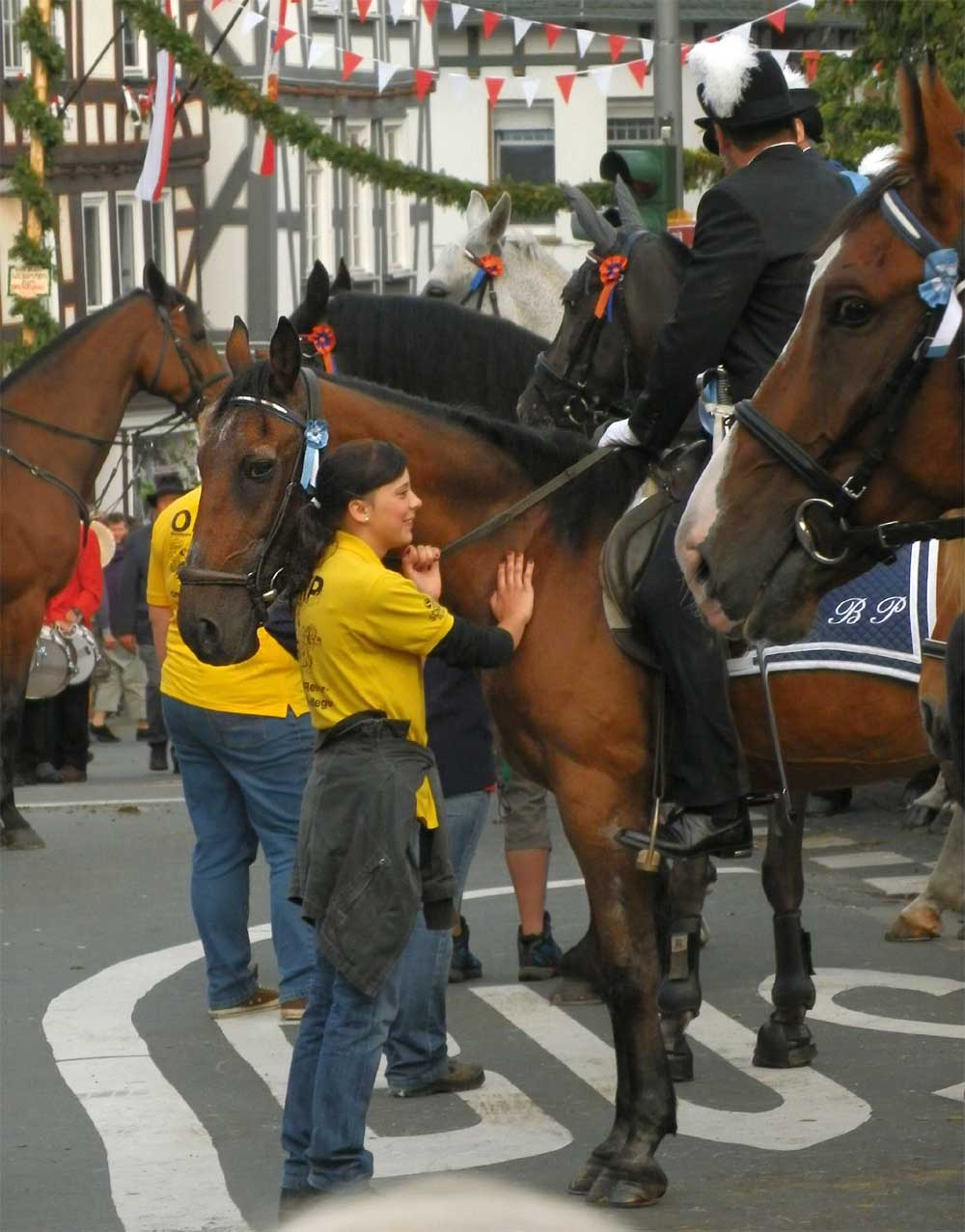
A horse is comforted by its personal caretaker during Biedenkopf's Grenzgang.
( bottom & contents )
THE UNIT OF GRENZGANG ORGANIZATION IS THE NEIGHBORHOOD CLUB. The neighborhood is the unit of organization here, and I've heard it was originally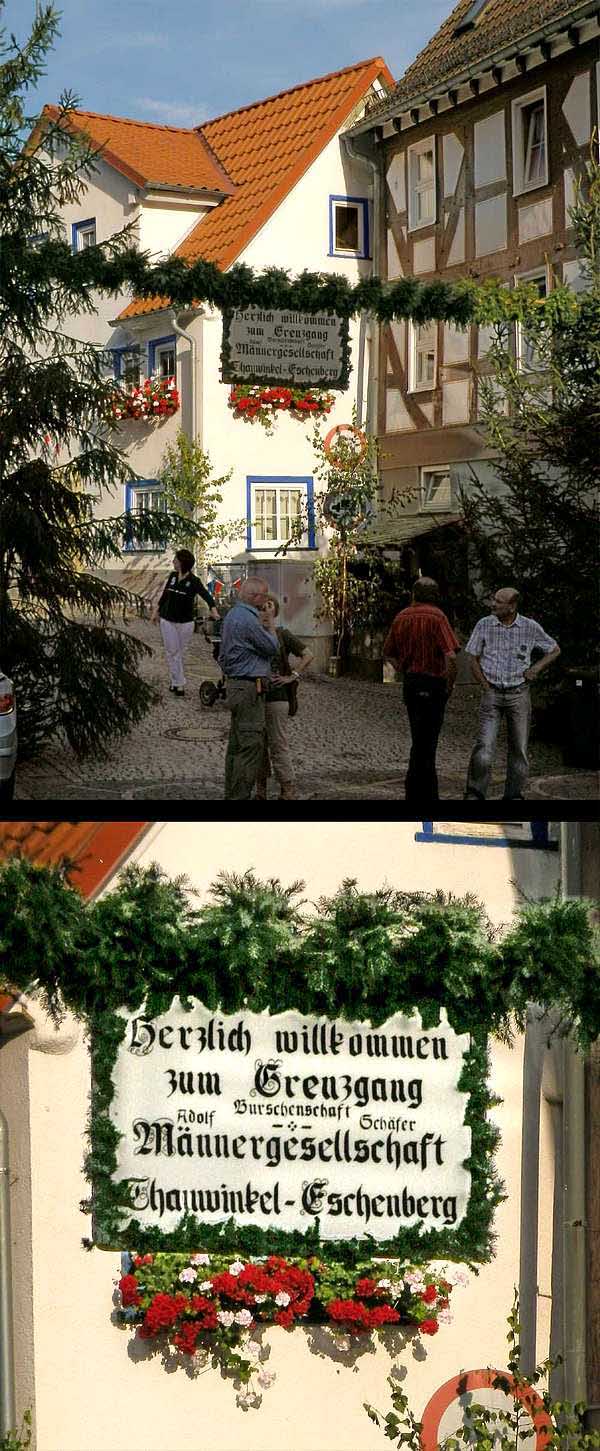 that way for the Fasching
Festival in Köln. Mardi Gras in New Orleans was not only
neighborhood-based, but Germans
contributed their Fasching traditions to it.
that way for the Fasching
Festival in Köln. Mardi Gras in New Orleans was not only
neighborhood-based, but Germans
contributed their Fasching traditions to it.
For six years in Biedenkopf, you have a neighborhood association and an excuse to have picnics and grill parties in the summer, but the seventh year brings serious demands on everyone's time.
On the seventh year, there's work to do and money to raise. Biedenkopf is forest-rich; every neighborhood is decorated with birch trees. Where a wall might have been dull or a view unsightly, I saw "Christmas trees in August" -- spruces over two stories high.
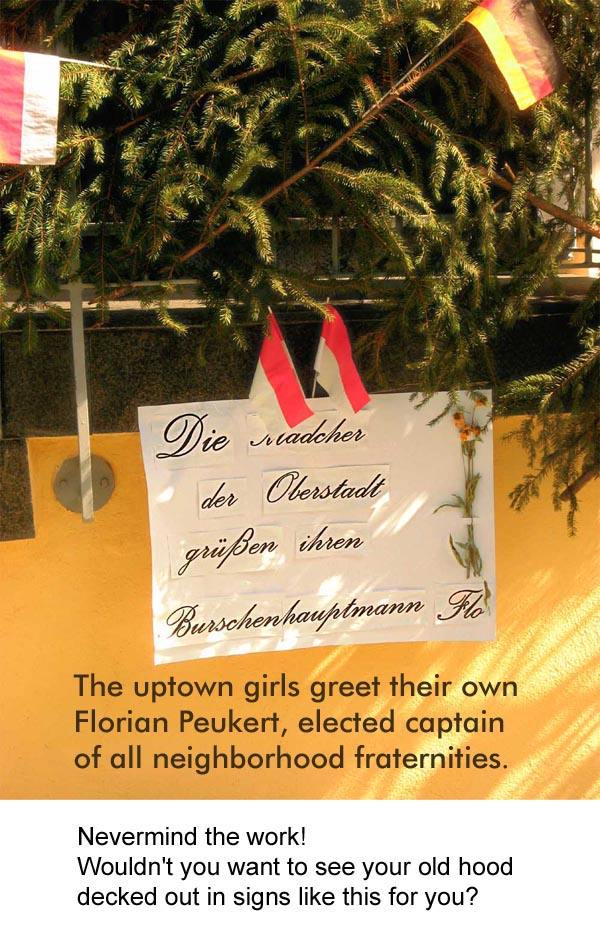 Behind every centuries-old male
formality stands a women's group. The
Balbach boy's fraternity (Burschenschaft) has its sorority, the
"Balbinen", the Hasenlauf
girls are all in their red shirts. And the mothers?
Traditionally, the evergreen
garlands across so many streets are hand-bound by the women
("Girlandenbinden," check the yellow assignment sheet). The pole for
the flag of every men's club or boy's fraternity has a Maypole-like
ring on
top. In behind-the-scenes ceremonies harking back to the Renaissance,
the narrow, ribbon-like pennants of women's groups are attached to the
flags carried by the men they pledge to support. Restaurants
totally closed to the public and filled with kids and clubs after we
thought Grenzgang was over become a noisy statement of how Birreköppers
(Biedenkopfers) define work -- or celebrate when it's over.
Behind every centuries-old male
formality stands a women's group. The
Balbach boy's fraternity (Burschenschaft) has its sorority, the
"Balbinen", the Hasenlauf
girls are all in their red shirts. And the mothers?
Traditionally, the evergreen
garlands across so many streets are hand-bound by the women
("Girlandenbinden," check the yellow assignment sheet). The pole for
the flag of every men's club or boy's fraternity has a Maypole-like
ring on
top. In behind-the-scenes ceremonies harking back to the Renaissance,
the narrow, ribbon-like pennants of women's groups are attached to the
flags carried by the men they pledge to support. Restaurants
totally closed to the public and filled with kids and clubs after we
thought Grenzgang was over become a noisy statement of how Birreköppers
(Biedenkopfers) define work -- or celebrate when it's over.
Not counting the official Fassmeisters (dispensing beer) and Bratmeister (grill chefs), the 8 Burschenschaften (fraternities) and 11 Männergesellschaften (mens' clubs) have 200 officials; we need special uniforms for 134 people with public marching roles. Suit, gloves, tie and sash, hat and feathers -- each must personally bear the cost of 450 to 550 Euros. For the official outfitter, the clothing is all special order, with Teflon for water and mud repellency, Spandex/Lycra for athletic flexibility, even a ceremonial sword opening. No, not "Made in China". You might survive all this in your most comfortable shorts; young idiots in flip-flops might survive it at all. But officials will come through in full uniform, and their gloves will be perfectly white afterwards.
The Moor ("Mohr," Martin Werner) and the two Wettläufer (Christoph Strieder und Karsten Plitt) are handled separately by a sporting-equipment-and-uniforms company. They need special outfits and shoes for months of athletic training, plus the final ceremonial costume. It's on the house -- the Grenzgang Komitee pays for the Moor, and all the Burschenshafts chip in for the two Wettläufer chosen from their ranks.
 The business muscle behind it all is the Grenzgangsverein
Biedenkopf
e.V. -- e.V., an "eingetragene Verein" (registered association or civic
club; this one founded 1886). The Grenzgangsverein Biedenkopf's 23
honorary members ("Ehrenmitglieder") serve on the Grenzgang Komitee
without pay. Word has it that Licher Bier in Marburg dropped out
of the bidding at 120,000 Euros, whereupon Bosch Bier, closer to home,
got the contract for supplying the entire event. We are not talking
barrels of beer -- this is buying out the overtime production of an
entire German brewery.
The business muscle behind it all is the Grenzgangsverein
Biedenkopf
e.V. -- e.V., an "eingetragene Verein" (registered association or civic
club; this one founded 1886). The Grenzgangsverein Biedenkopf's 23
honorary members ("Ehrenmitglieder") serve on the Grenzgang Komitee
without pay. Word has it that Licher Bier in Marburg dropped out
of the bidding at 120,000 Euros, whereupon Bosch Bier, closer to home,
got the contract for supplying the entire event. We are not talking
barrels of beer -- this is buying out the overtime production of an
entire German brewery.
German registry laws for becoming an "e.V." like the one that runs Grenzgang mostly stipulate transparency about who is responsible for what the association does and for the contracts it signs. American non-profit registry laws (e.g., for 503(c)3 or 503(c)6s) mostly stipulate how to avoid taxes, how to engage in politics without losing tax exempt status, and how much you can hide your donor list, because you already know what kind of politics you want to engage in once you have the money. Think tanks that drive lobbying mostly hide their donors and are mostly 503(c)s.
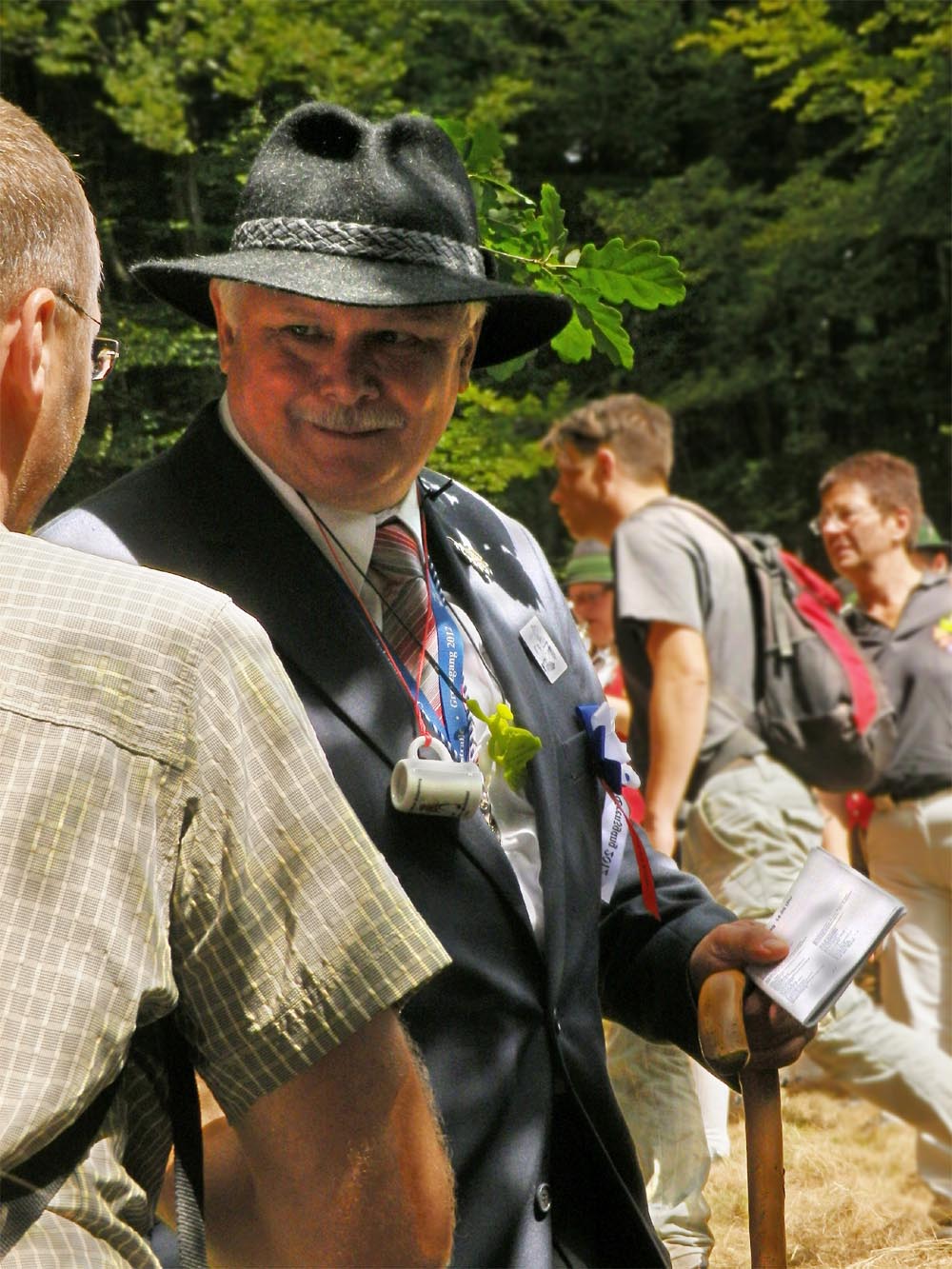
Arnd Prätorius, Vorsitzender (Chairman) of the Grenzgang Komitee, gets to ask the $64 question on the November preceding a Grenzgang year:
” Sell da Grenzgaank ‘naus gieh?”
(Soll der Grenzgang hinaus gehen? --
are we heading out on the Grenzgang or not?)
Jaaaa! has come the answer from citizens for over 300 years.
Vote taken.
BANDS, BANDS, BANDS
( bottom & contents )
We came for the exercise, but, after you bring in over 10 marching bands from as far away as Austria, you might as well regard Grenzgang as a traditional music festival.
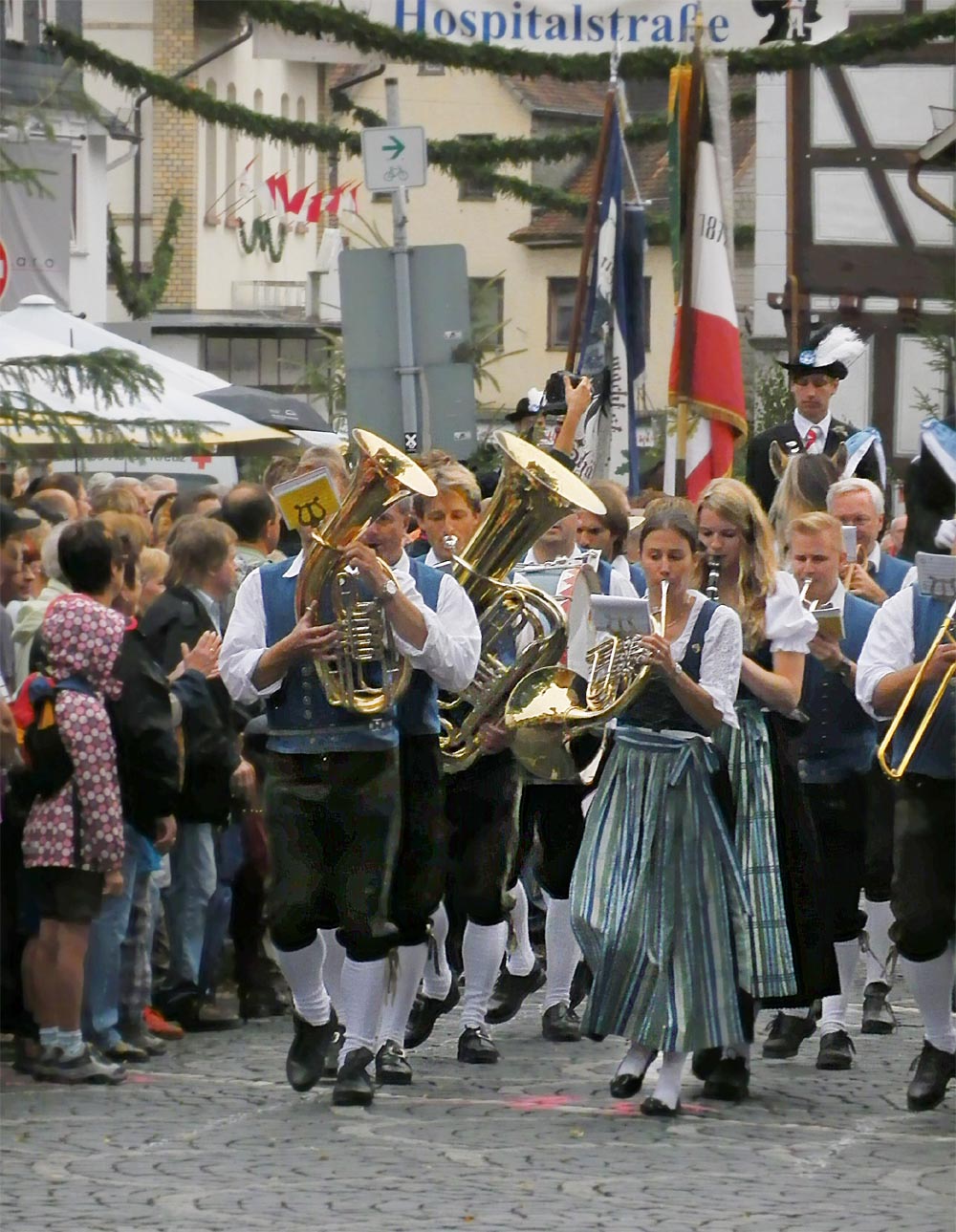
The Stadtkapelle Marktoberdorf, reinforced by their Jugendblasorchester (Municipal band of Marktoberdorf plus the Young People's Wind Orchestra) -- all supported by a town of 18,000 population, and surrounding villages -- in the Bavarian foothills of the Alps. One group of small rural towns helps another.
There were 6 other bands positioned all over the place, not all doing processional marching like this one. And at night? I can't speak to the live dance bands added on top of all the marching and non-marching traditional bands. The Dance Tent was down in the valley, and we were up in our Park Hotel, half-dead under the pillows.
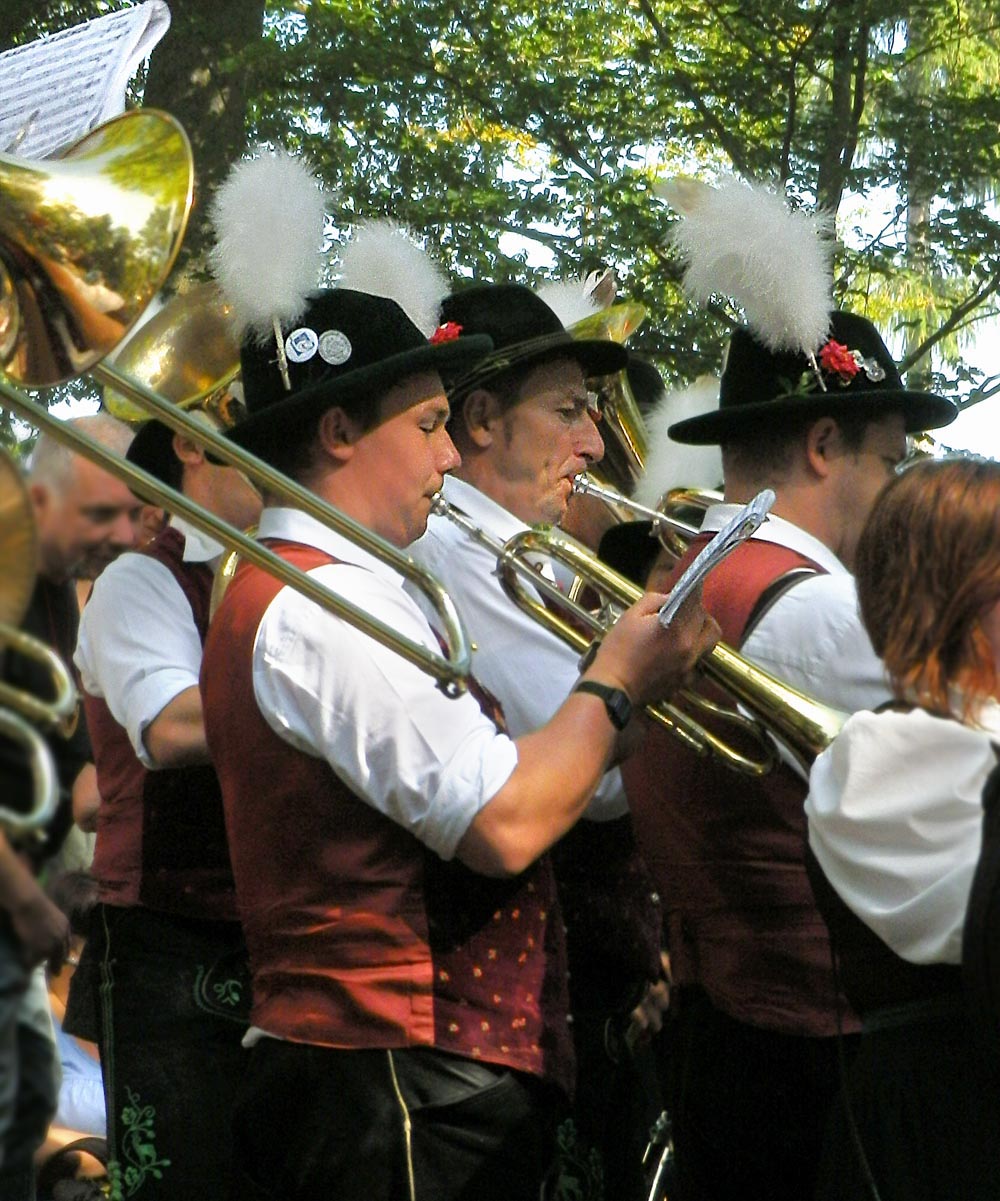
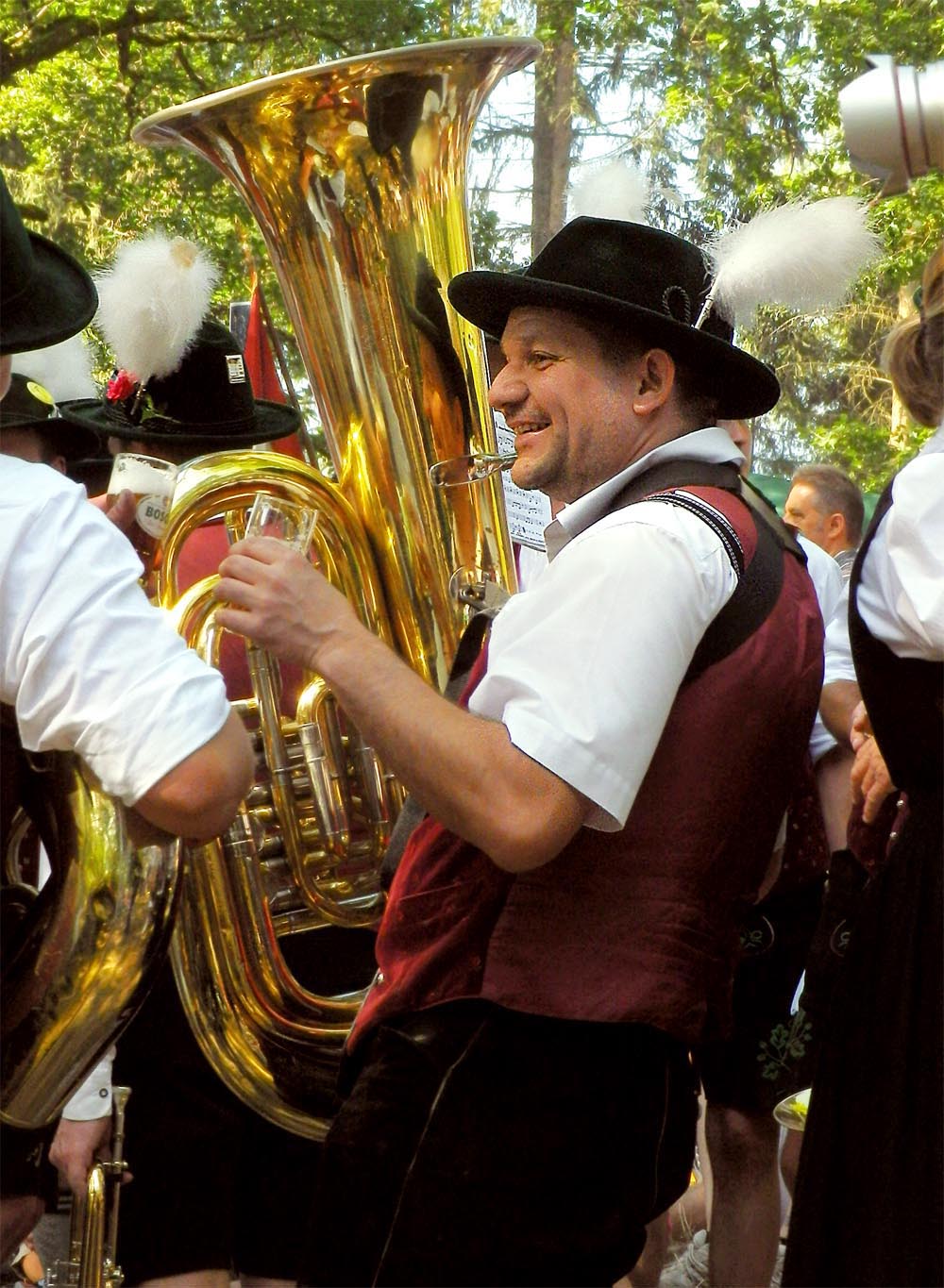
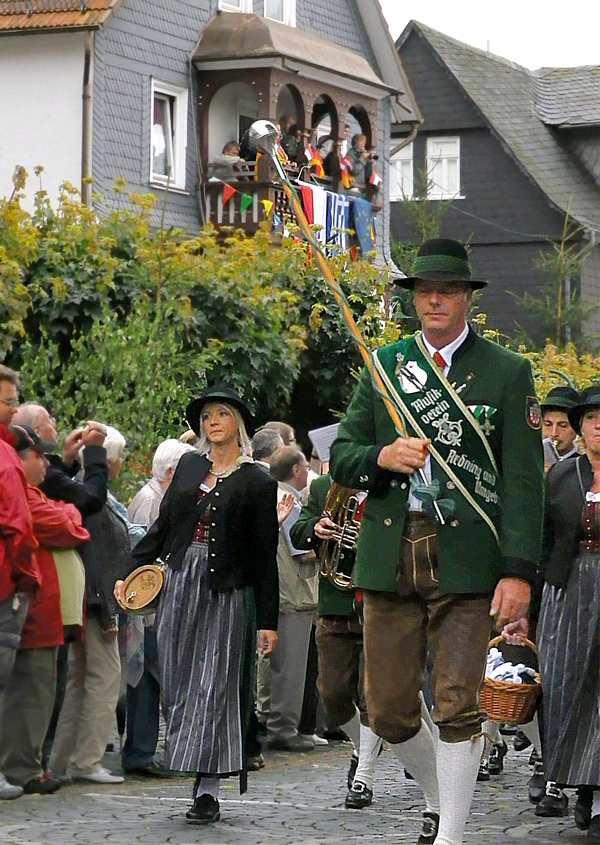
DEEP AND QUIET
( bottom & contents )
The forest was as quiet as the Marktplatz was noisy.
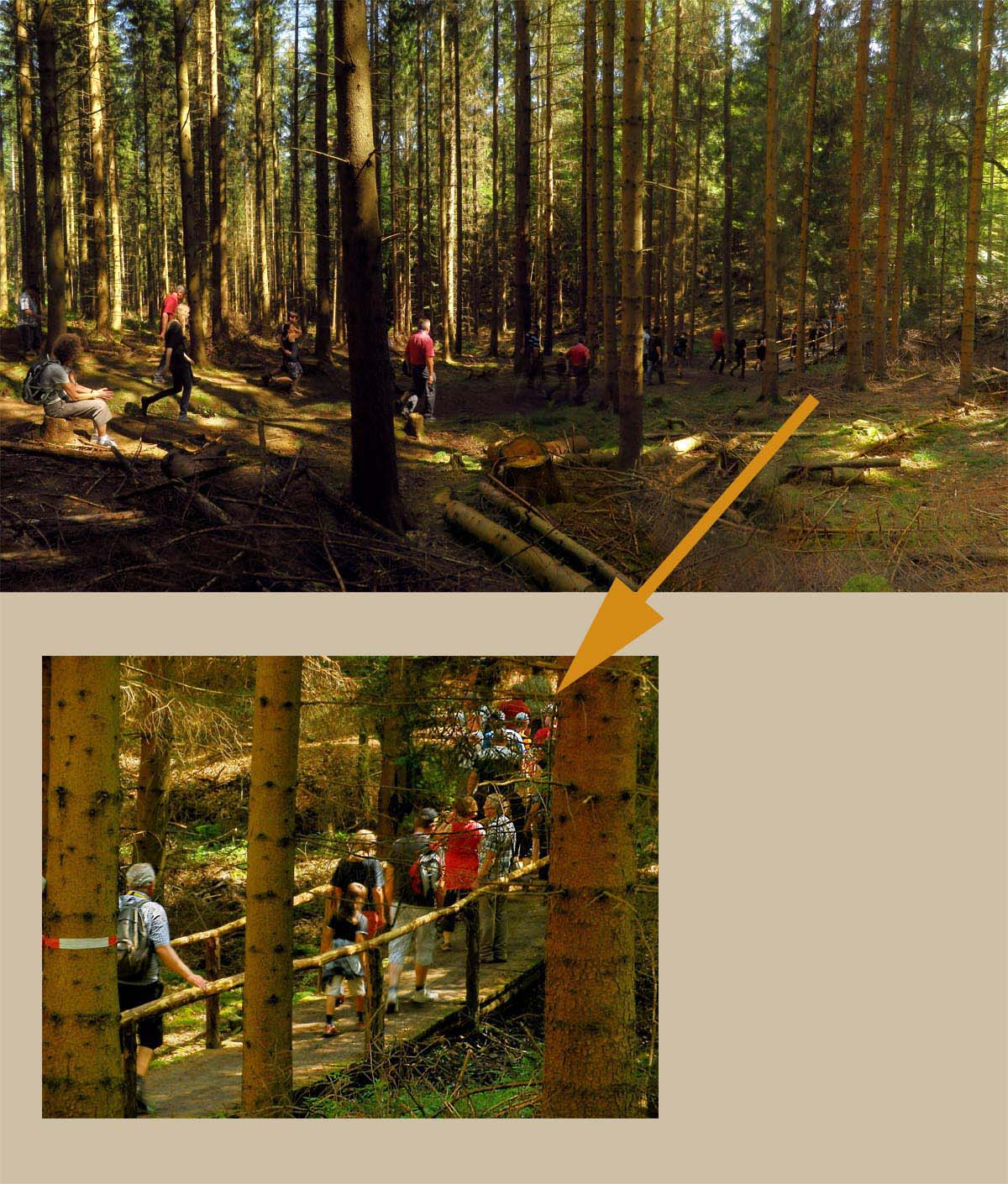
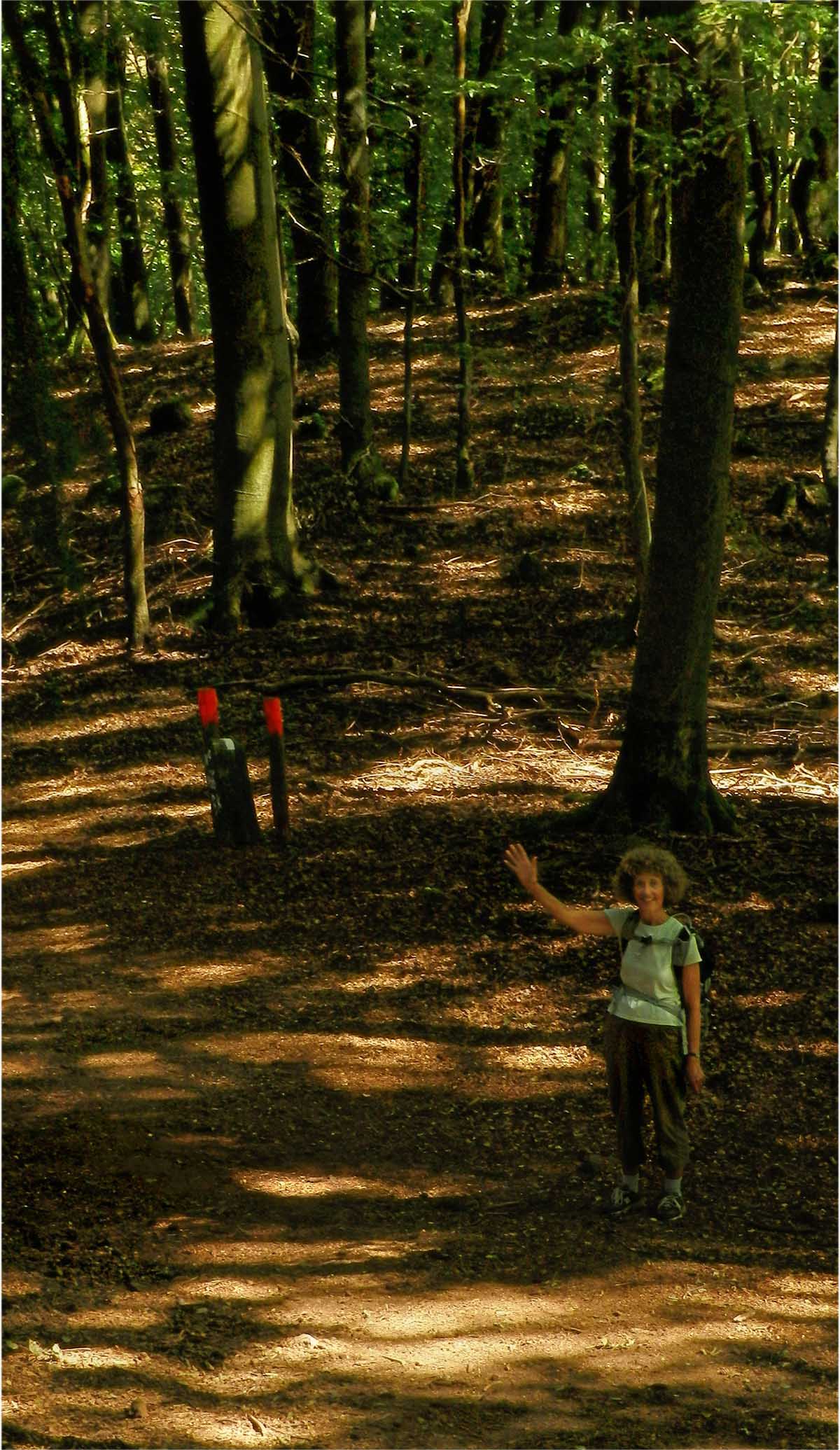
Robin Hannay Nelson, 2012
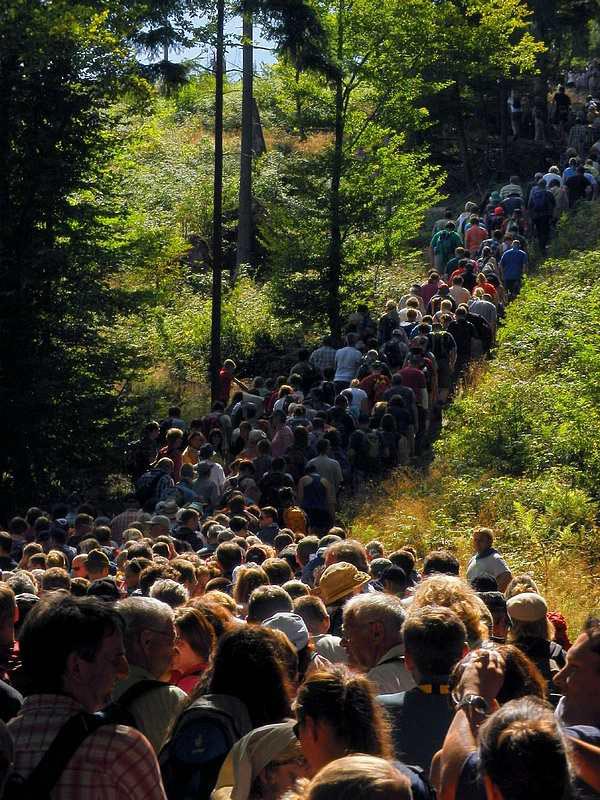 Robin figured it out first -- "Stau" (congestion) is a Bad
Sign . . .
something is wrong if the
Robin figured it out first -- "Stau" (congestion) is a Bad
Sign . . .
something is wrong if the
people cannot get through. On the other hand, no matter how far behind we dropped, the nearly impossible passages held up everyone else too, and we stragglers could rejoin civilization.
What the photo cannot show is the endlessness of all this -- the little patch of blue sky you see is **not** the hill we are cresting here. Some places brought us to single-file, thousands strung out for kilometers. Oddly, we kept greeting the same people, and again the next day. Perhaps we were equally decrepit, set the same pace, wound up at the same place in line. Thousands of strangers, sweeping views, and you greet and make a stable set of friends. You wonder what walking the pilgrim's path to Santiago d'Campostella would be like . . .
Each Grenzstein (boundary stone) is numbered -- how long before we see an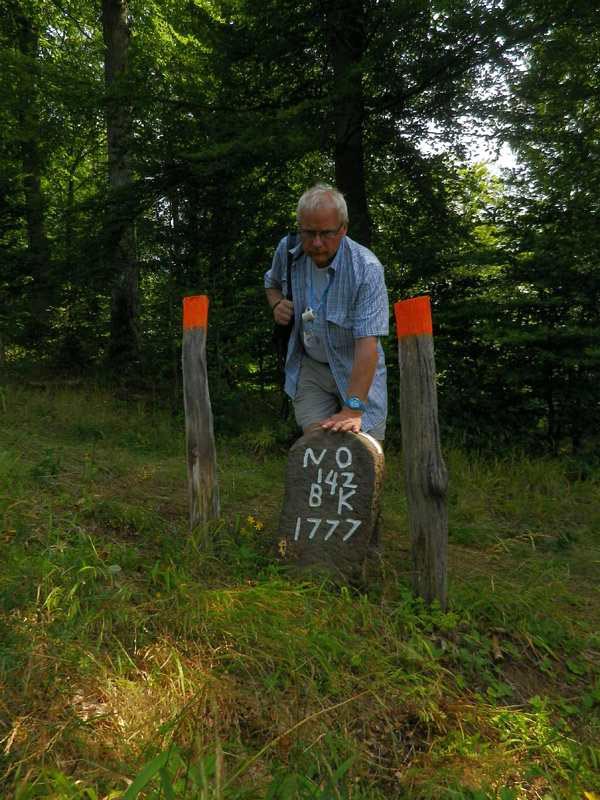 iPhone + GPS app for proving you touched each one?
We could get
Nintendo/Niantic to run the entire Grenzgang march as a Pokemon Go game.
iPhone + GPS app for proving you touched each one?
We could get
Nintendo/Niantic to run the entire Grenzgang march as a Pokemon Go game.
The oldest stones went in in 1777, once the European movement to create a central, coordinated register of land surveys, ownership and taxes in a formal document, the "kataster" or cadastre, had reached this part of Germany.
We are marching to the Frühstücksplatz (breakfast place). Every day's march breaks at a huge meadow, a different one on each segment of the border that we march each day, with beer, bratwurst, and relief for everything that hurts. But first you have to get there.
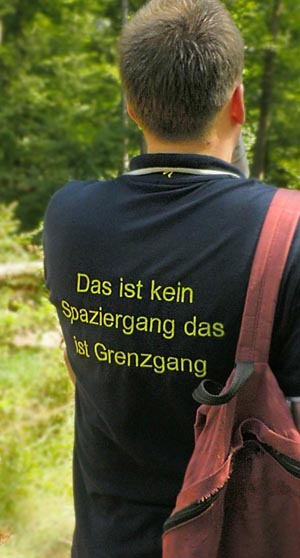
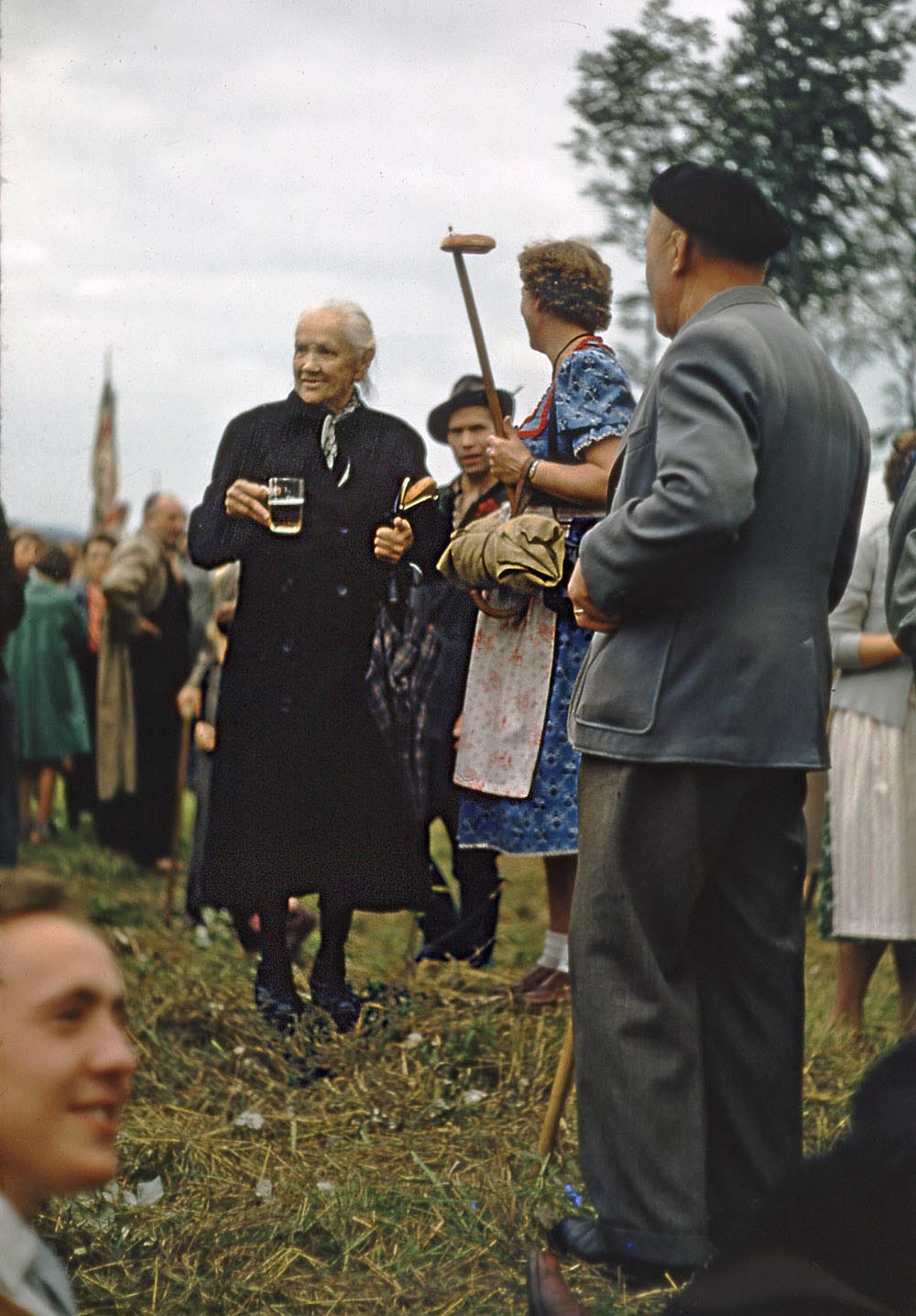
April, 2012: Robin and I hiked, trained, swam for months before getting into this. Old ladies in traditional costumes are gone now, but I remembered them from 1956, the Ladies in Black, the gray-haired ladies steaming past me, alte ladies from the Altstadt. There were no buses then, the cop-out buses to the breakfast meadow. 1956 Ladies in Black probably hiked the steep streets on the castle's hill all their lives. But Robin & I made it, and we passed kids in impossible foot gear -- or just overweight -- now standing aside: the videogame generation meets gravity. Thoughts circled around for another pass as I waited for sleep: now I was the gray-haired person they would remember.
FRÜHSTÜCKSPLATZ: BEER & BRATWURST
( bottom & contents )
It looks just the same with your eyes closed -- a vast acoustic space with a different top-notch band in every direction, the sound of Charles Ives, "Three Places in New England". Ambient recording of the soundscape (not individual bands! not any track of any song!) would be wonderful. The digital sound recorders are not expensive (Tascam DR-100, or the H4n) but they are complex and it'll take time until you two are both friends. The microphones need windscreens and must point away from each other, not at any target. In order to generate a wide stereophonic sound stage of wide sound phase differences, any well-separated, non-directional, external pair of mics beats the built-in ones on the recorder. But even that will be just great. I tried it on my dinky camera's feeble stereo recorder and it is sadly clear that a real recording will conjure up the entire ambiance, and my photos, no matter how big I try to make them, never will. Three meadows, three days of happy madness, the biggest last.
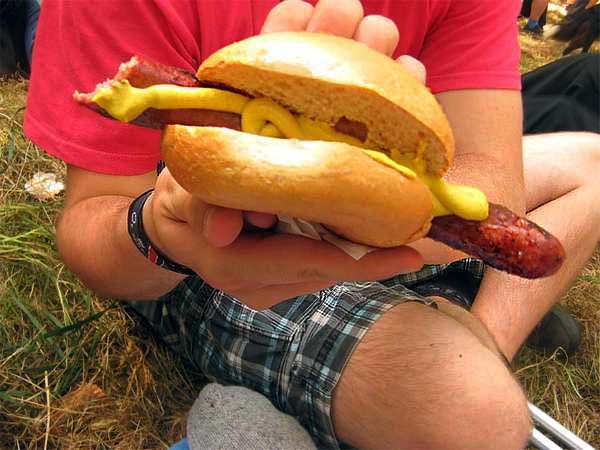
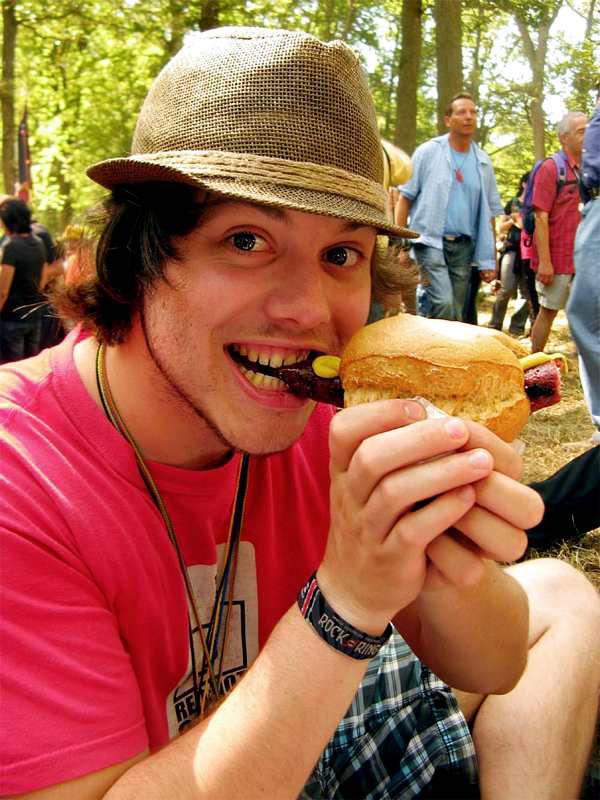
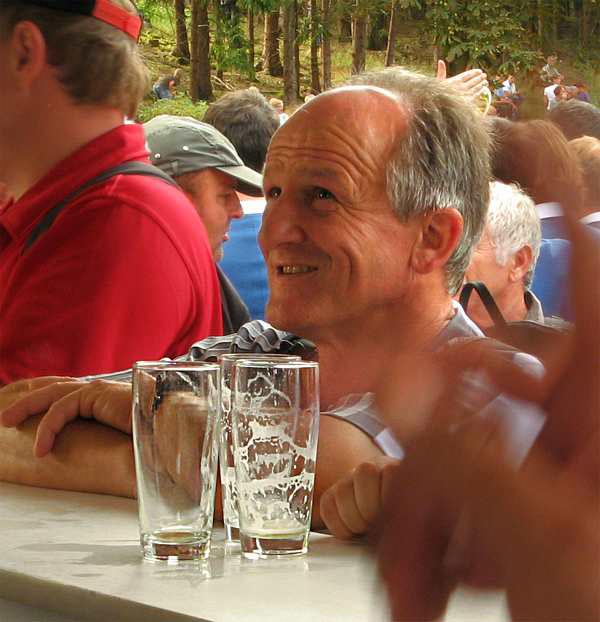
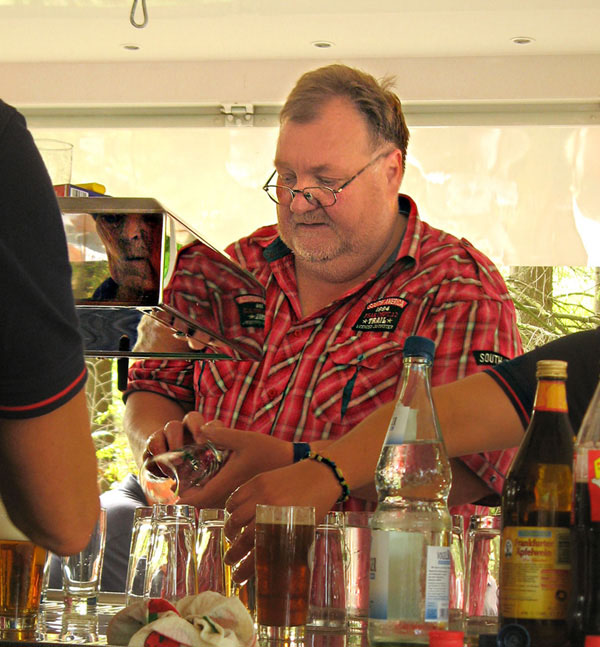
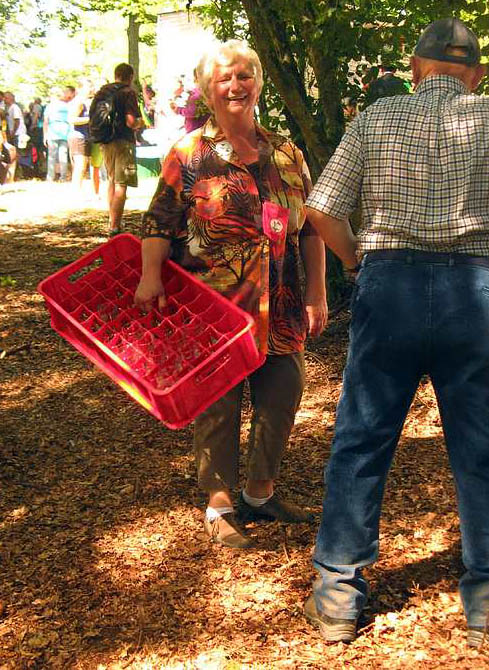
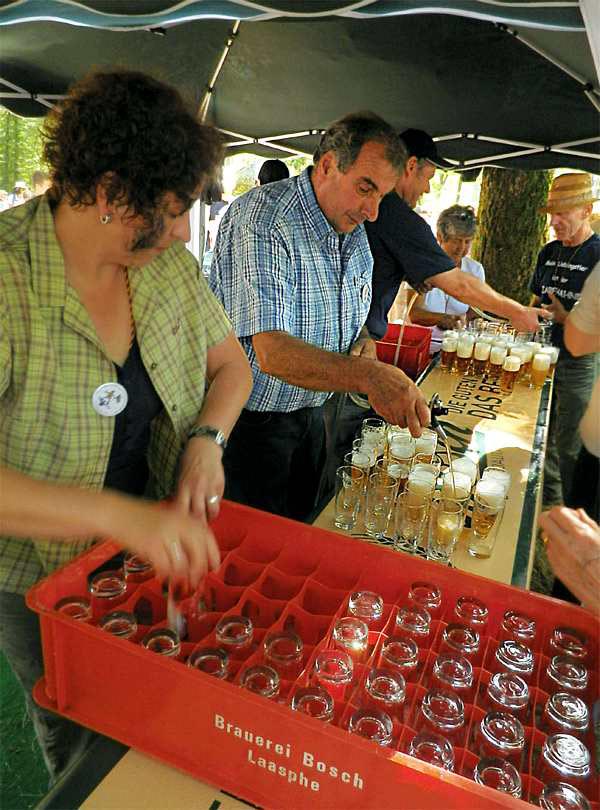
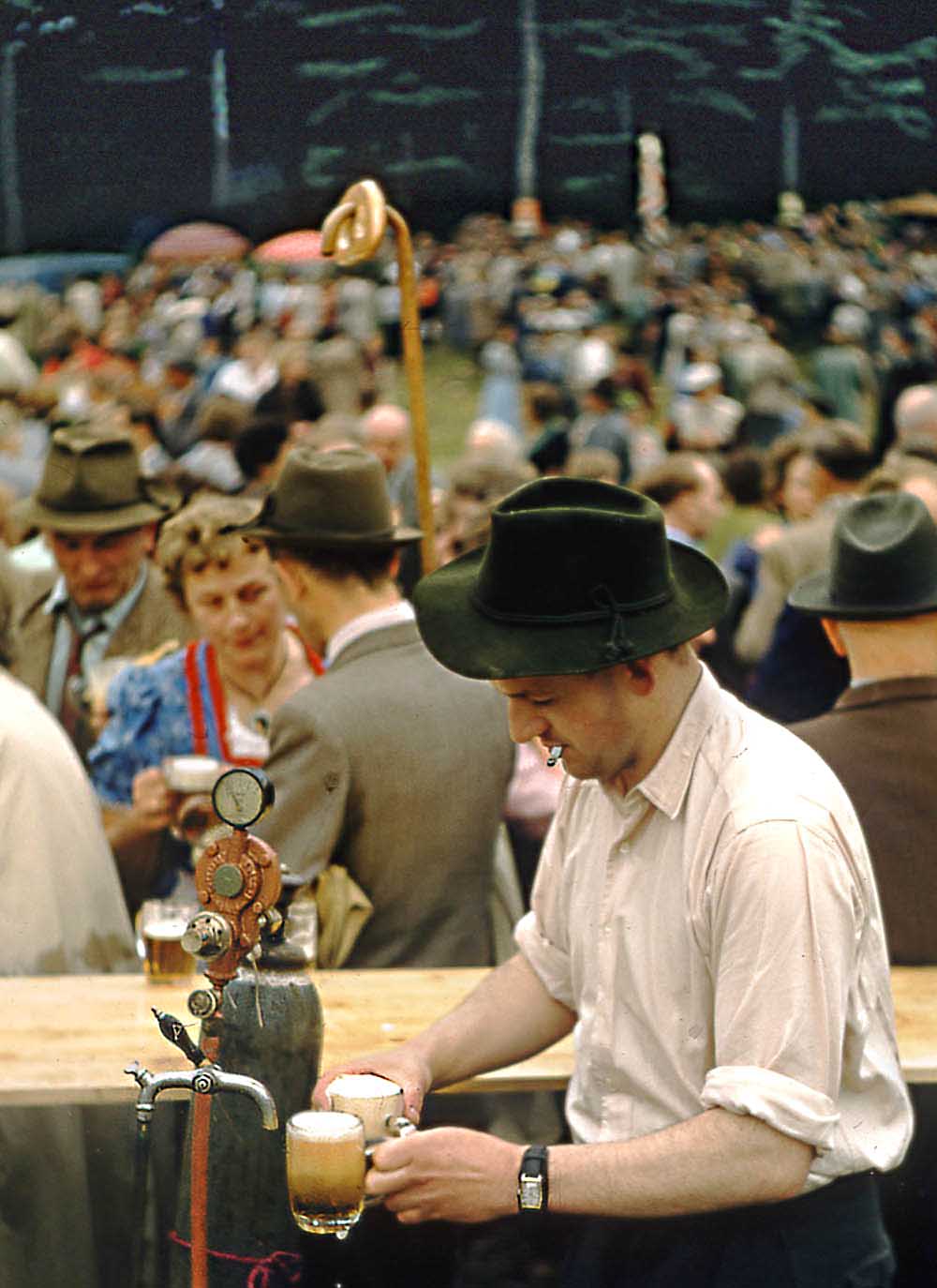
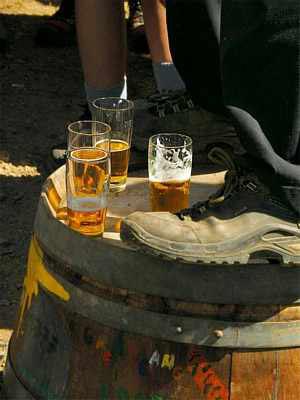
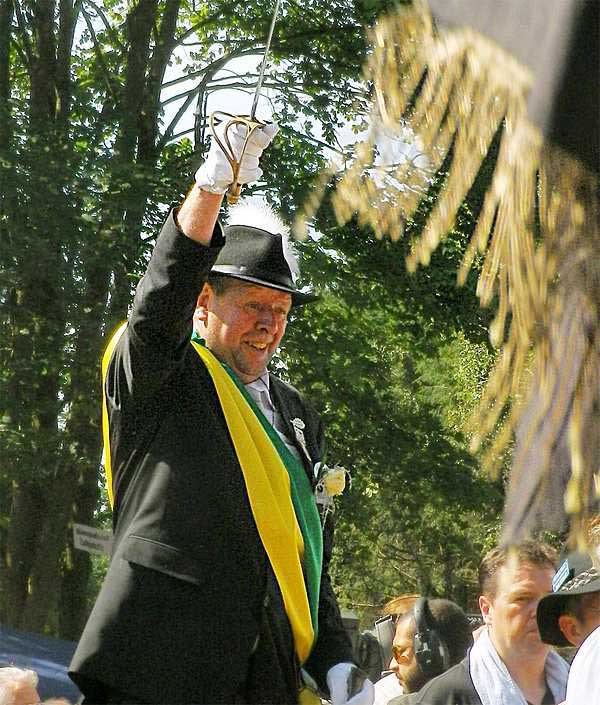 After beer and bratwurst, what you have to do
at the Frühstücksplatz is
huppchen -- pay your dues at the men- or boys' club of your choice, and
get tossed thrice, preferably over a Grenzstein, by four strong club
members on either side of your supine form. The flag that was carried
out of the
Marktplatz and all the way up to this meadow is waved over your feet,
the ceremonial sword at your head, the uniforms are perfect, the
After beer and bratwurst, what you have to do
at the Frühstücksplatz is
huppchen -- pay your dues at the men- or boys' club of your choice, and
get tossed thrice, preferably over a Grenzstein, by four strong club
members on either side of your supine form. The flag that was carried
out of the
Marktplatz and all the way up to this meadow is waved over your feet,
the ceremonial sword at your head, the uniforms are perfect, the 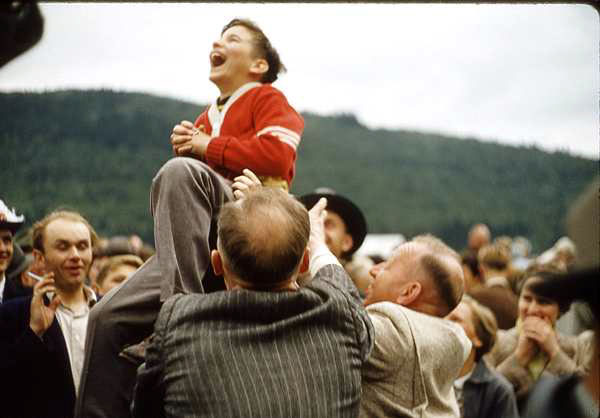 gloves are white, the men stand tall, very tall . . . on
beer
kegs, of course.
gloves are white, the men stand tall, very tall . . . on
beer
kegs, of course.
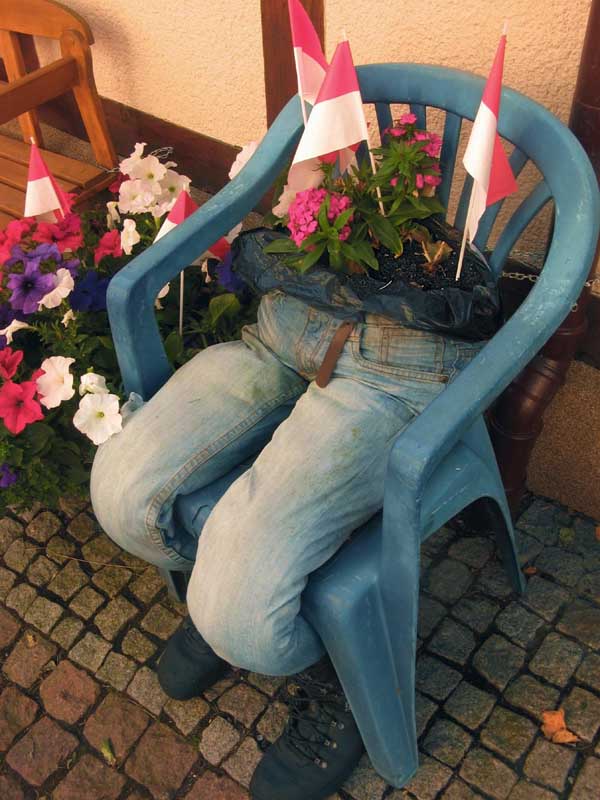 My blanket toss in 1956
My blanket toss in 1956
and a playful planter in the Oberstadt.
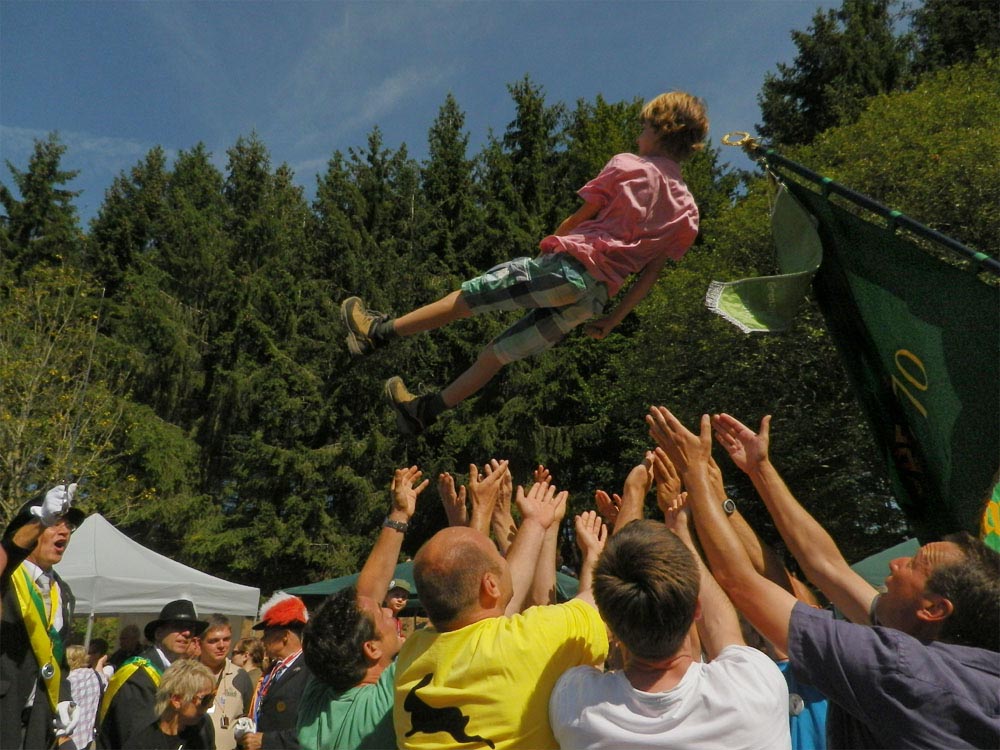
Got some trailmix left somewhere? Too late for bratwurst now, break's over!
You were up at six, it's only noon. The Wettläufer cracks his whip and we need to march -- half the hike left to go.
Three days, three different sections of the border, three different, large meadows, owned and administered in perpetuity by the town. For the town.
The cracking comes faster, he pulls snaps to the left, to the right, get moving!
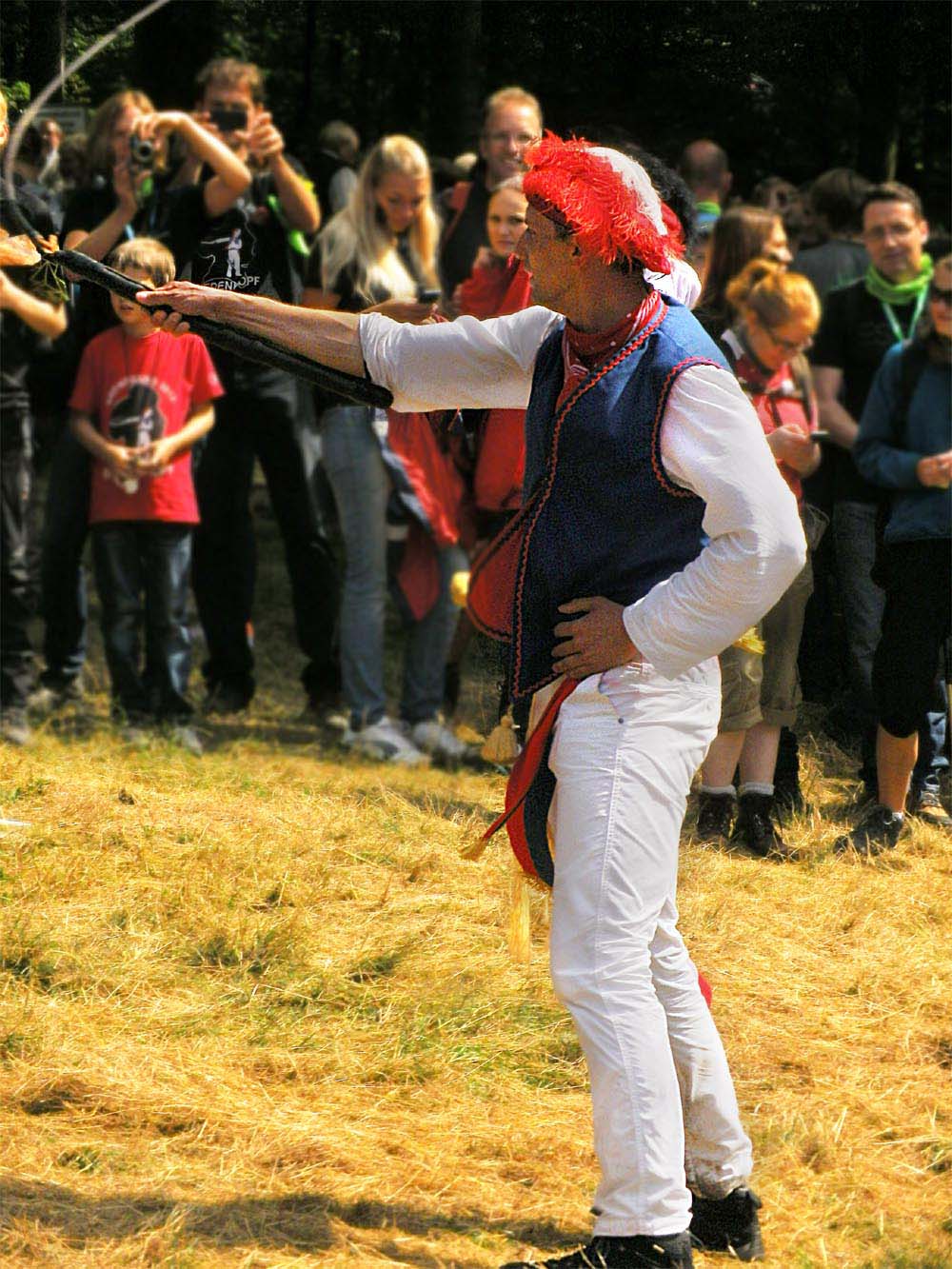
THE VICTORIOUS ARMY's TRIUMPHANT MARCH BACK DOWN INTO TOWN
( bottom & contents )
Yes, but first there's the final descent -- Robin says it's worse than in 1991, "They're making this into an Extreme Sport event to attract the young people."
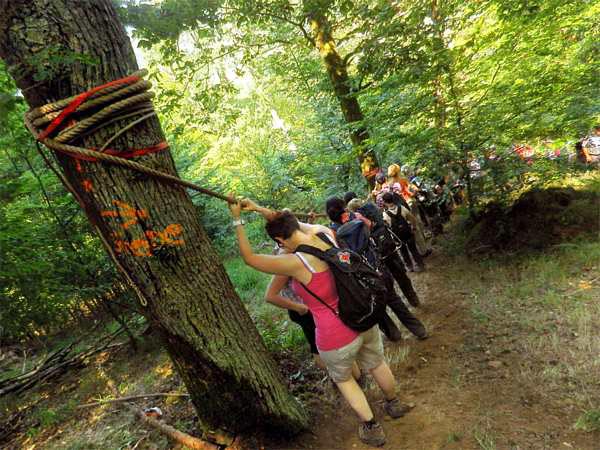
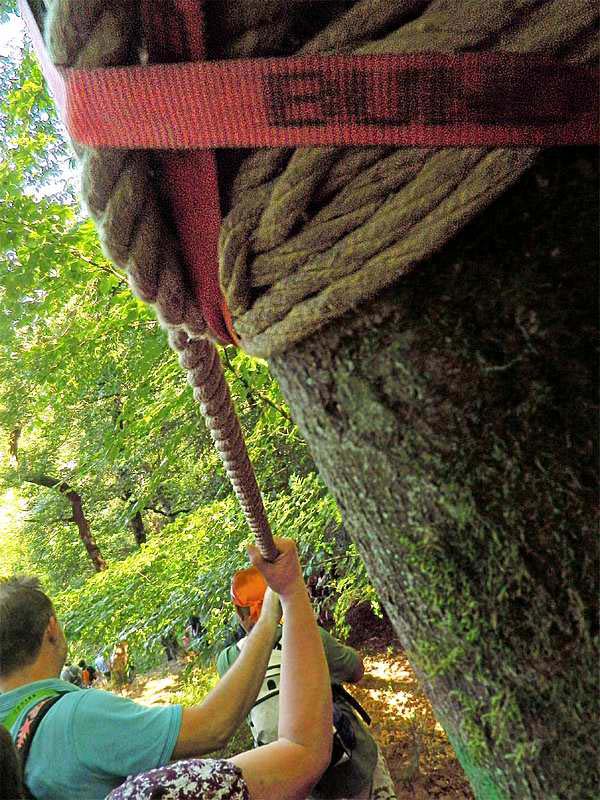
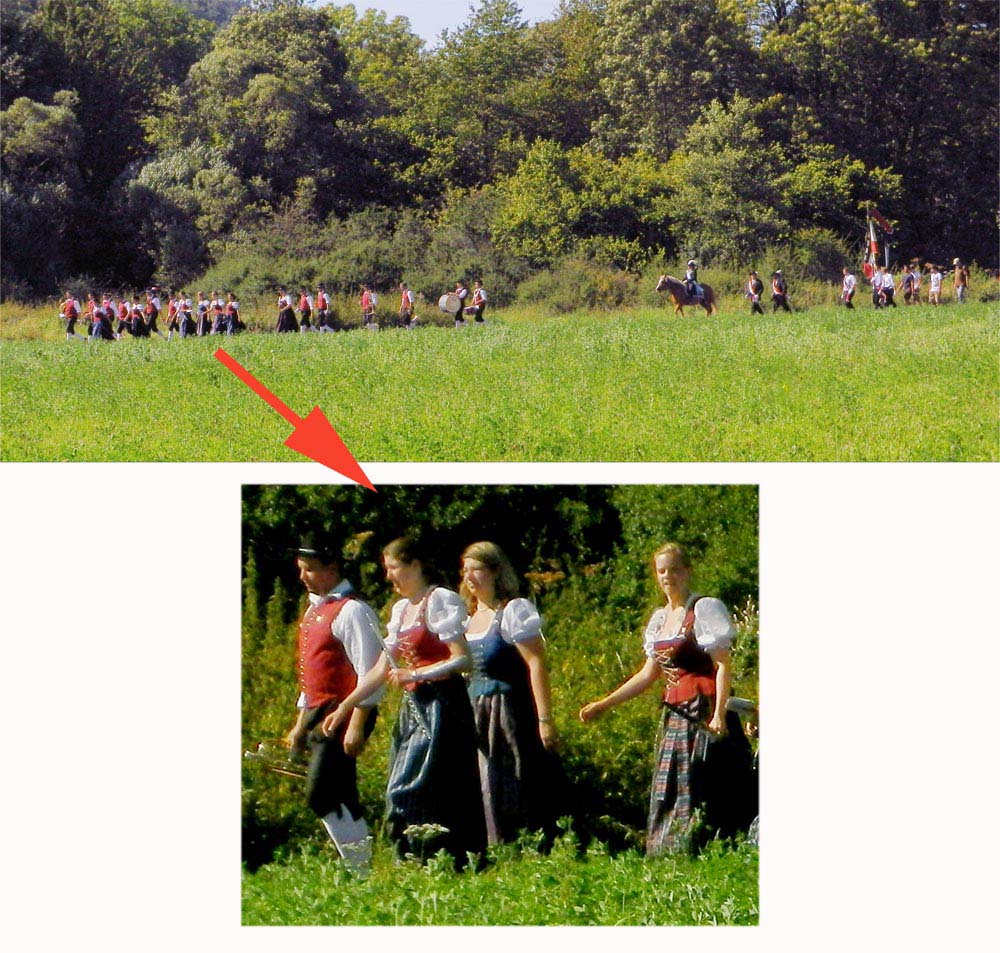
Spielmannzeug ("playing man [musician] parade") Stötten leads on. There are 19 men's clubs and boys fraternities -- this one will make the Day 3 entry into town in style, with horse and rider, flag carrier, and the Musikkapelle Stötten to announce their coming.
Has any marching band ever marched more than these top national ones do at Grenzgang?
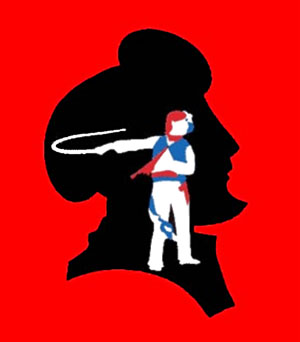
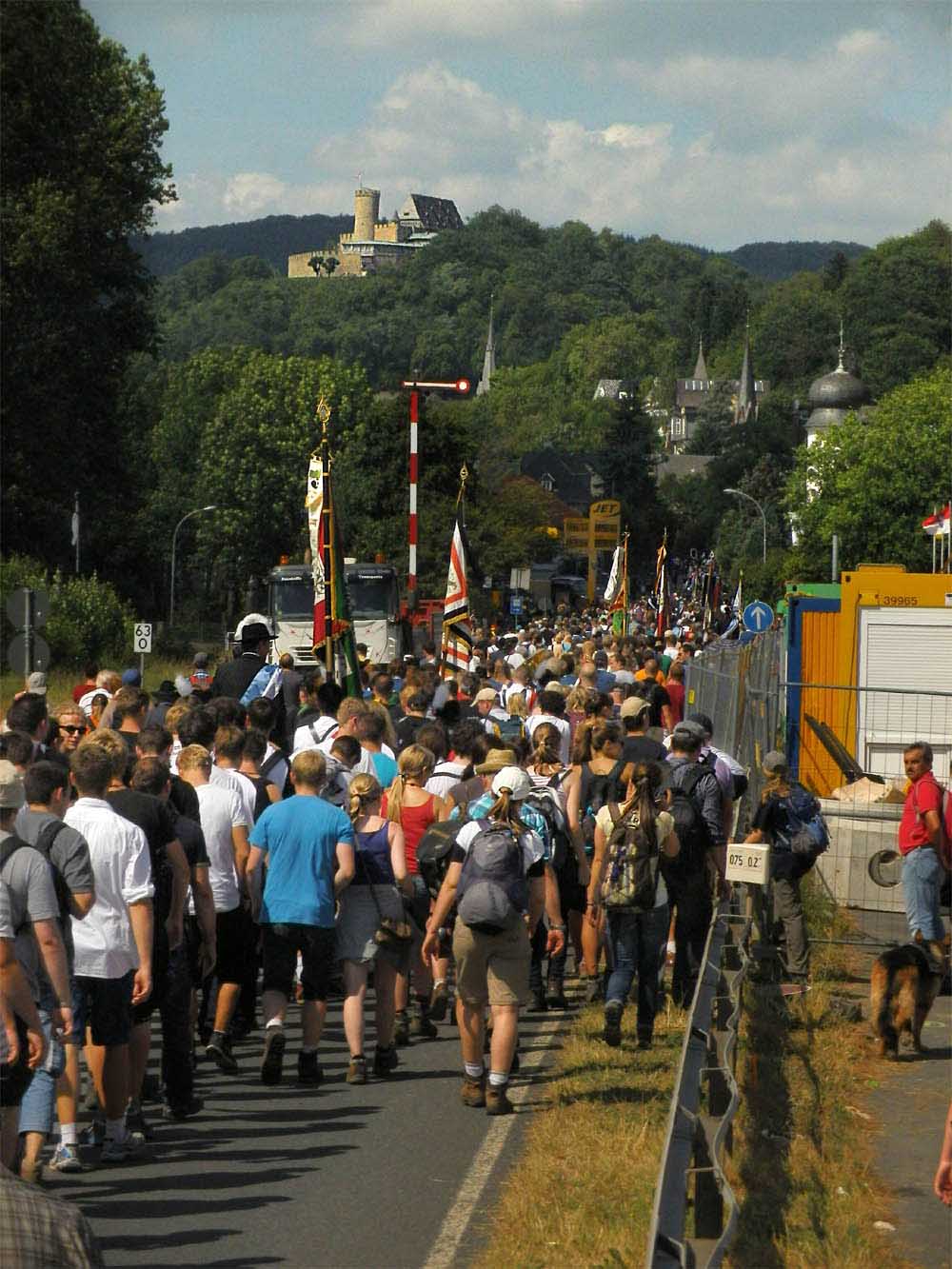
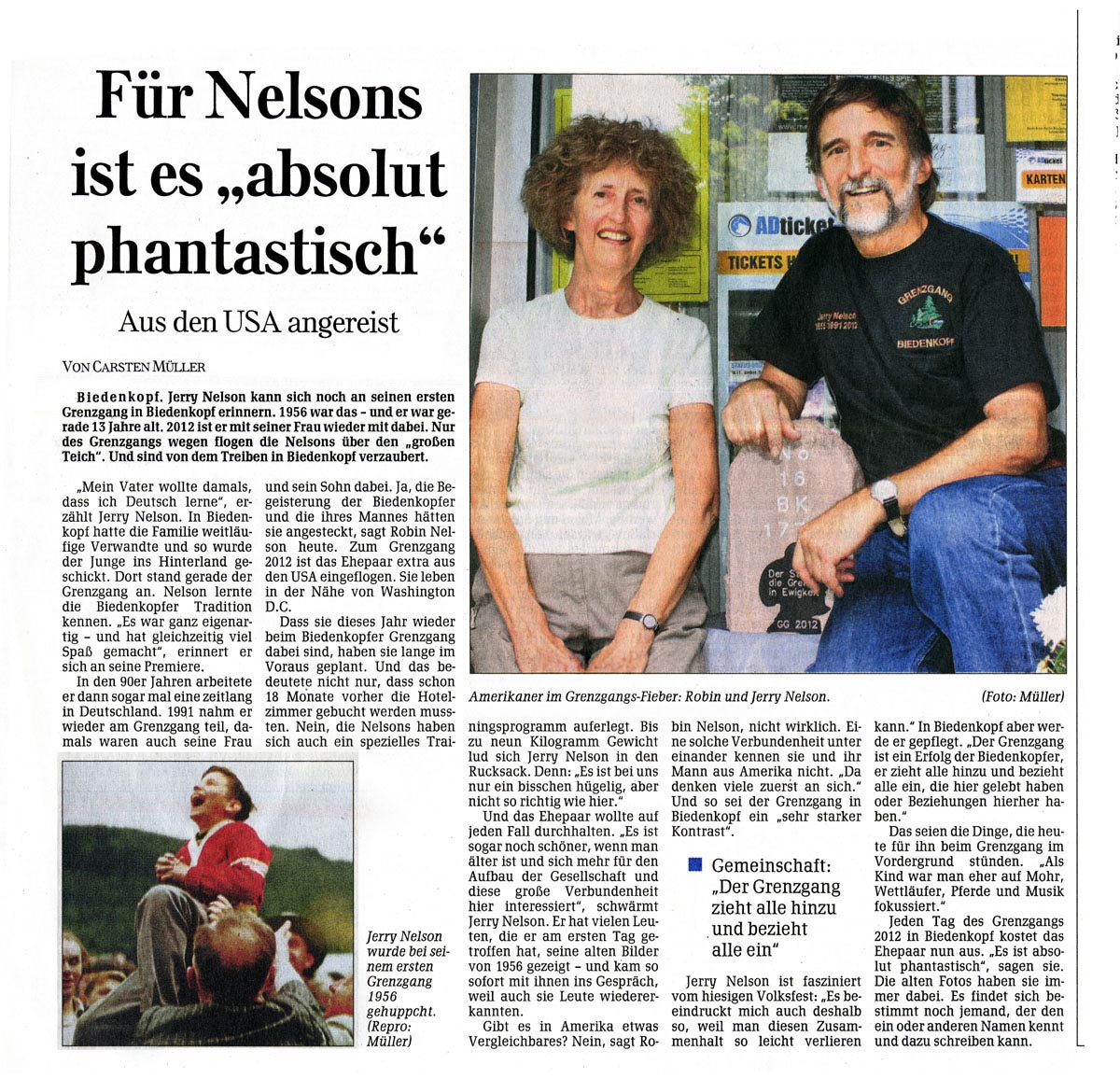
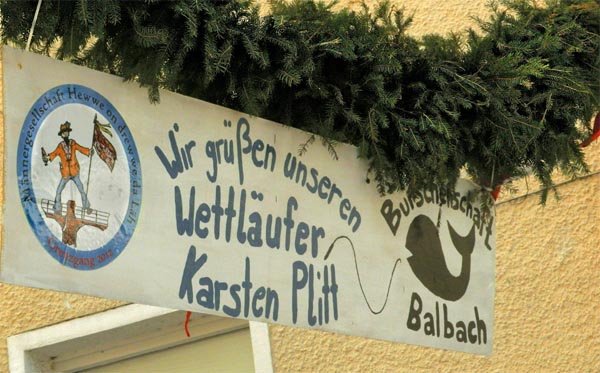
THE FAIRGROUNDS & AMUSEMENT PARK
( bottom & contents )
We always got back into town around 3:30, the stragglers at the end of the line, with no time for the enormous amusement park installed on the Lahn valley meadow, featuring a beer tent and dance floor as big as any at Bavaria's Oktoberfest (thank you, Bosch Bier). The parades and events down there brought the girls out in force -- the Balbinen from Balbach, and the Hasenlauf ("rabbit run") neighborhood girls in the afternoon ( http://mg.hasenlauf.de/pfe/2012-2-grenzgangstag-nachmittag/ scroll down to photos of kids in red shirts). These are the sororities associated with the best of the Burschenschafts. Dancing went on past midnight . . . all with live bands, but not with us, and definitely not with the other bands, the marching bands that would be up at 4AM and in costume and in tune for the 6AM cannon shot, fired up to cheerfully let the rest of us know that we were already late.
CORPORATIONISM vs CIVIC SOCIETY
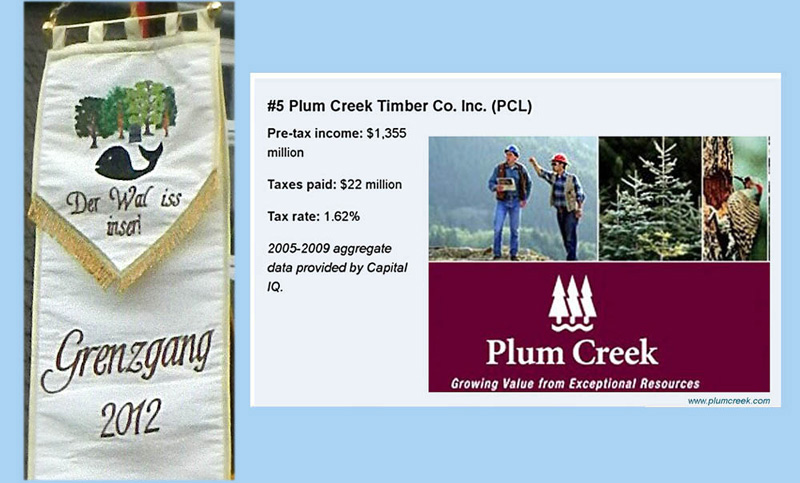
Our old neighbors in Bürgeln cared for us while we recovered before visiting friends in Frankfurt. We shared rooms in a creaky old hotel with our son and grandchildren, and then we were home again, able to do things just not possible while traveling. I love the music loud in our cathedral-ceiling living room.
"I just can't understand why nearly 400 watts of audio power can't manage to sound any better than this."
"Because you're going deaf."
With best wishes from
Robin & Jerry Nelson
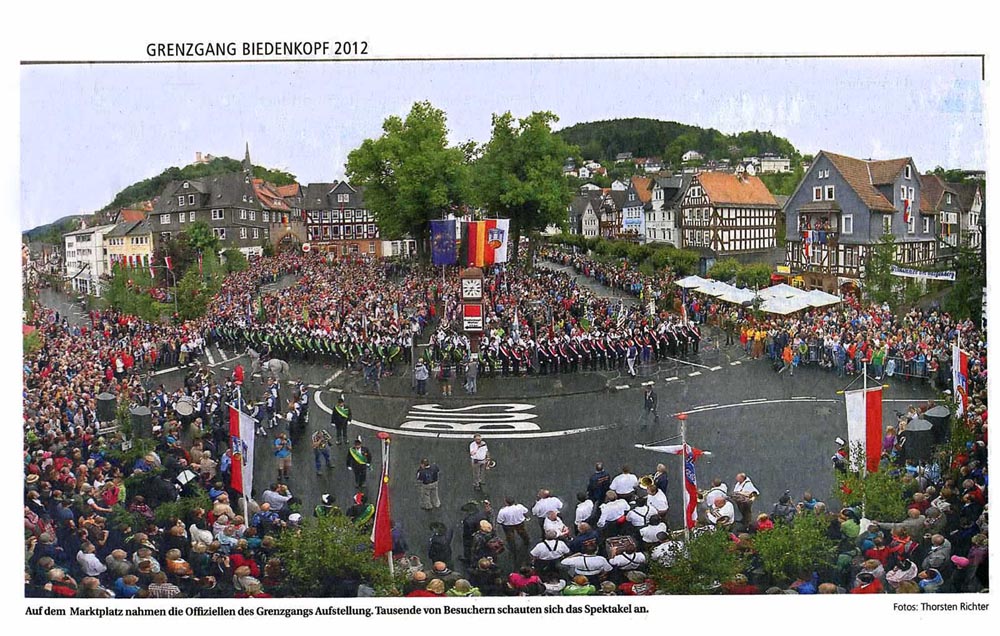
A WALK IN THE PARK ( bottom & contents )
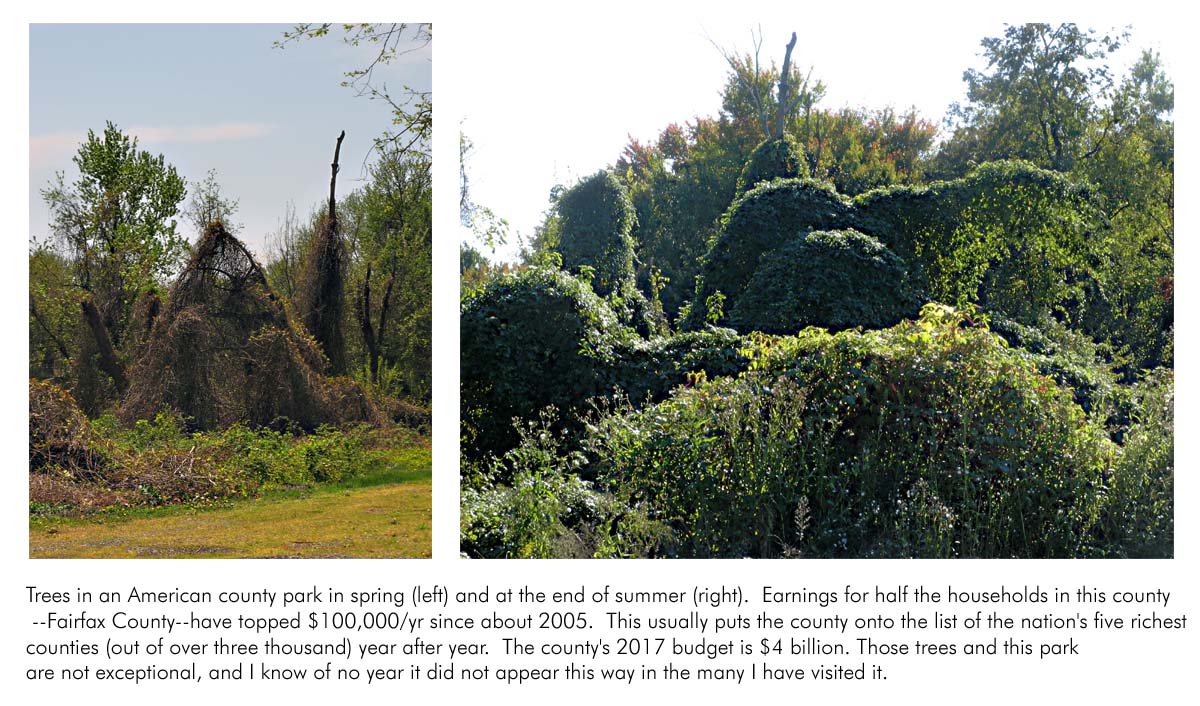
top
THIS IS PAGE ONE
PAGE TWO -- MAPS
PAGE THREE -- MORE OLD PHOTOS from Grenzgang 1956
home page for this small website (travel essays, mostly)
home page for my other website (technology, politics, art, literature, complaints about life, how many stamps to put on an envelope . . . )
Liebe Leute! Bitte an jerry-va at speakeasy dot net Korrektur u. Verbesserungen schreiben.
Kann jemand irgend welche Teil übersetzen? Ich könnte es vollziehen, hätte ich von anderen den Anstoß. Beihilfe kann nur an bessere, ausgebreitete Redewendung, Ausdrücke, Wortschatz hinführen.
Danke.
Rev 19Aug2016
Grenzgang Biedenkopf is the biggest, friendliest German Volksfest you never heard of. Join them once every seven years and do the border rounds ("Grenz" "gang") to make sure the surrounding nobles haven't moved the markers and cheated the Biedenkopf Burgers (citizens, as in "PittsBurg") of their forest lands. Unfortunately, the borders go straight up and down the mountains.

It started two years early for us, when we got reservations for the last rooms left in town at the Park Hotel. After months of training we flew to Germany, checked into our hotel, and surveyed Biedenkopf in the Lahn valley below. It was all there: Fachwerk (open-timbered) houses surrounded a central Marktplatz (marketplace; arrow left), and crooked streets in an Altstadt, the old town, that found their jumbled way up to a castle on the hill. But we weren't here to storm the castle. Our job was to defend the forest -- check every marker and show grass-roots unity against any midnight cowboy moves by surrounding noblemen. Grass-roots unity means thousands marching out with us at dawn, and we would all have to go straight up the hills and back down to the next one. We watched the sun set over an awful lot of hills.
Here are my pictures of Biedenkopf's Grenzgang 2012, a civic festival (Volksfest) I had participated in as a child in 1956, and came back with Robin to do One More Time. I will be 76 in 2019, so "one more time" may be the last time for us. But to start at the beginning -- this is not Disney Castleland and this is not a bierfest.
THE MIDDLE CLASS SAYS "NO" TO THE MIDDLE AGES
( bottom & contents )
In a culture of landed aristocracy, how did ordinary townspeople ever come to have anything to defend?
When people can't make Things, money comes from agriculture. In the Middle Ages, manorialism ("the Lord of the Manor") organized peasants into villages whose residents owed rent and labor services to the nobles. A freeman who owed more than he could pay became a serf. Feudalism added a military class of knights. Lower-status nobles owed military service to their overlords, in return for land and the right to exploit the agricultural underlings who lived there. Rents were collected, mercenaries were hired to sally forth, and defensive walls against all this Medieval silliness went up around neighboring towns who didn't want to be part of the game.
What the wonderful wars of the new military class could not accomplish was completed by the Black Death. About one-third of the European continent's population died in the the plague from 1347 to 1350. But the military class did make a contribution: soldiers' movements spread fleas harboring plague bacteria across Europe.
Town dwellers slowly invented tools, recipes, ways of making things . . . and banded together across towns into guilds, to protect and pass on trade secrets, and propel trade itself. The productive innovations of guilds of craftsmen produced accumulating wealth, and the bourgs of Central and Western Europe developed into cities dedicated to commerce and home to a rising bourgeoisie.
When the new middle class was still weak, the protective power of guilds was important for resisting the extortions of local feudal landlords. Units of political organization soon loomed ahead of guilds busy protecting the trade and trade secrets of skilled craftsmen. Small monarchies arose as the bourgeoisie supported a distant king or queen to suppress their own local royalty -- the hated lords of the manorhouse.
By the late 1500s and early 1600s, the bourgeoisies of England and the Netherlands had become the financial and thus political force that deposed the feudal order. It was a time when many German towns celebrated their commercial power with the construction of a Marktplatz ("market" "plaza" or place). In the Marktplatz, wealthy multi-story open-timbered "Fachwerk" houses took up any space not given over to ornate guild halls, wool and banking exchanges, and everyone's symbol of self-governance, the Rathaus or town hall.
Biedenkopf didn't get very far after entering written history in 1254. It built a castle (only 700 years old, unless you dig deeper on the north side), but, always and first, Biedenkopf tried to protect its large holding of forest lands. The Grenzgang -- "going the Grenze" or border -- was first mentioned in 1693 for protection of border markers. A stone can mark a border, but only a piece of paper can freeze its location and ownership. Slowly, Europe compiled a "kataster" or "cadastre", a combination geological survey, deed register and & title authority, so midnight marker moves by the noblemen's nefarious flunkies weren't worth it anymore. Keeping up with the trend, Biedenkopf replaced the piles of rocks, marked trees, and wooden posts with stone boundary markers in 1777, and the Grenzgang became largely ceremonial. But the idea that you could keep what you had was not yet settled.
FINALLY & COMPLETELY: THE WOODS ARE OURS
( bottom & contents )
The borders to be marched took their final form only in 1832. The Großherzogliche Oberforst-Sekretär Hoffmann (the Forestry Chief Secretary of the Grand Duchy [of Hesse]) had to sit down with the lowly Gemeinde (county) of Biedenkopf to "clarify" (reduce) the Gemeinde's forest holdings, document the agreement, and submit the document for full and final ratification by Land Hessen -- at that time, an independent country still nearly 40 years away from statehood in the belated emergence of the German nation. Properly clarified, the town's forest lands shrunk by about one-third, but Biedenkopf won complete administrative control of its forest lands, and the borders marched in celebration for "Grenzgang 1839" are the same borders we march today.
---Hinterländer Anzeige Sondernummer, 15 August 1956, page 5.
Victory at last? The upper classes sniffed.

FÖRSTER OPPOSES GRENZGÄNGER TRAMPLING THE WOODS. The landed aristocracy -- the Prussian Junkers and House of Hohenzollern up north, the Grand Duchy of Hesse (Großherzogtum Hessen) down here -- they all had their vast estates and meaningless hunting rituals, but looked with disdain when citizens came up with their own holidays, like going out to hunt border markers without horses.
Still, there were times on steep and stony paths when we thought of the Großherzoglich Hessische Revierförster von Zangen -- the Grand Duke of Hesse's District Forrester for Biedenkopf -- had a point when he opposed the Grenzgangs of 1848, 1857 and 1864: . . .
that it is namely a huge, purposeless act of punishing drudgery,
to run around 3 days long on the arduous borders of Biedenkopf --
and then on top of that, to call this a pleasure --
that is something we indeed appreciated long ago,
that this imaginary pleasure is so deeply rooted in Biedenkopf,
that one might as well not oppose it.
"... daß es nämlich gweiß eine große und zwecklose Strappazze ist, 3 Tage lang
an den so beschwerlichen Grenzen der Biedenkopfer Gemarkung herumzulaufen und
dieß noch obendrien ein Vergnügen zu nennen, so haben wir doch damals schon
eingesehen [understood, appreciated, accepted], daß dieß einbegildete Vergnügen
so tief eingewurzelt in Biedenkopf ist, daß man ihm nicht entgegentreten soll."
--Hinterländer Anzeige - Sondernummer 15 August 1956, page 3
The Grand Duke resigned himself to the imperturbable commitment of the town's citizens to hold the festival, but, by 1879, festivities were canceled by the town's own political leaders "for lack of interest".
FINANCIAL BUBBLE, SPECULATIVE WEALTH, BETTER THINGS TO DO

( bottom & contents )
The Grenzgang faltered in 1879.
As victors in the Franco-Prussian war of 1870-71, Germany got the spoils: five billion French gold franks, which Germany melted and re-cast as billions of Goldmarks. Biedenkopf's mayor and town council looked wistfully at the speculative boom in railroad construction, which led to a boom in coal and steel industrialization -- and an 1873 financial collapse that depressed the economy into the 1890s. The mayor announced a vote of zero funds for Grenzgang. Citizens! Seize tomorrow, get rich! People wanted tomorrow, not festivals celebrating a bygone past. Germans turned away from small rural towns with forests, agriculture, silly folk customs, and no industry. For a 20th century parallel, see Robert Putnam's "Bowling Alone" and his portrait of Americans who no longer value civic engagement or regard relationships with neighbors as worthwhile. There was no Grenzgang 1879.
The citizens still wanted Grenzgang even if their government didn't. They formed their own committee (Grenzgangs-Komitee, 1881), collected over half the funds needed, stacked the town council with two elected members from their organization, and staged the 1879+7=1886 Grenzgang with minimal town funding.
Even the mayor was swept away by the enthusiasm and success of the restored celebration, and the entire town is unstoppable today.
All of Europe went through the transitions from manorialism and feudalism to guilds, bourgeoisie towns and small nations-to-be. Perhaps half a dozen towns hold similar festivals, but the Biedenkopf Grenzgang is probably the largest. Our job: get through it alive.
BREAKFAST
( bottom & contents )

If you're already late by 6:30AM, are you sure you want to do this?
OK, click on the photo, you'll feel better.
KOMMERS
( bottom & contents )
The town was thrown open to all guests on Wednesday, before marching began the next morning.
a

Wed. 15Aug2012. Bands, beer and
bratwurst everywhere -- the town mixer or
"Kommers"
for all Grenzgang guests the day before marching begins.
for all Grenzgang guests the day before marching begins.

Click to enlarge.
Once you have the HiDef image, most browsers will let you go up and down to any size you want with the CNTRL-+ and CNTRL-minus keys.
Once you have the HiDef image, most browsers will let you go up and down to any size you want with the CNTRL-+ and CNTRL-minus keys.
Grenzgang 1956. By 2012, the
house on the left had gotten its stucco
stripped,
revealing the original open-timbering.
Zur Krone on the right re-did its attic story. Photo: Gil Nelson; restoration: Jerry Nelson
revealing the original open-timbering.
Zur Krone on the right re-did its attic story. Photo: Gil Nelson; restoration: Jerry Nelson
Every street leads to a different neighborhood, a different street party . . . a crowded alley, beer benches wall-to-wall, a band.
 Here in town, only my childhood
friend Hartmut Eberspächer is left. On childhood vacations living with
his family, we were "Hewwe on drewwe da Läh" --
outside of the old town, "in and around the Lahn" or "rueber und
drueber der Lahn" in proper German. So I found the gathering for that
neighborhood and sat down next to a stranger. Eventually I pulled
out my Dad's photos, the 1956 Grenzgang -- the airport taxi had been in
the driveway as the last sheet came off the printer, but I was here now
and goddammit I had them all.
Here in town, only my childhood
friend Hartmut Eberspächer is left. On childhood vacations living with
his family, we were "Hewwe on drewwe da Läh" --
outside of the old town, "in and around the Lahn" or "rueber und
drueber der Lahn" in proper German. So I found the gathering for that
neighborhood and sat down next to a stranger. Eventually I pulled
out my Dad's photos, the 1956 Grenzgang -- the airport taxi had been in
the driveway as the last sheet came off the printer, but I was here now
and goddammit I had them all.It's a big weekend, the biggest in seven years. Noisy people were having a beer with close neighbors, with out-of-town family that made it back. A stranger (me), probably with a terrible foreign accent, sits down in the middle of all this and rummages around for photos from half a century ago. The man I sat down with immediately labels the people on one photo and says "Over there, try him, he probably knows more." "Yes," the next guy says, adding a name. "For a long time she ran a store on the Marktplatz."
I'm a city boy. Are all rural towns are like this? Maybe you could you do this anywhere in the US -- sit down with prints of Dad's 50+ year old slides of the county fair, find anyone who looks old, and she/he will start to label all the people.
Should I find the owner who ran the store on the Marktplatz? I could send her her own copy of the photo after I get home.
"Where can I find the Marktplatz store owner?"
"She died a week before Grenzgang."
ALL LINED UP
( bottom & contents )
Here's the plan. If the mayor can get everyone in town out of bed and lined up on the Marktplatz, then he and his deputies can march out of town with enough citizens behind them to deter anyone from pressuring the town into selling out the forest ("Stadtwald") or, in the old days, deter anyone from just moving the markers in the night and taking it.
You might sleep through a cannon blast from the castle on the hill, but half a dozen of the best marching bands in Germany and Austria are already in uniform and waiting for that signal, and you can wave your warm, soft bed goodbye.

All lined up.
It's 7AM and -- yes, it's 7AM, you can look at the clock. It's 7AM, and we're running late, but this is where we want to be:
all lined up in the Marktplatz, 19 neighborhood groups, the leaders in black suit, white gloves, sash and sword,
with their entire neighborhood club behind each one, lane after lane.
It's 7AM and -- yes, it's 7AM, you can look at the clock. It's 7AM, and we're running late, but this is where we want to be:
all lined up in the Marktplatz, 19 neighborhood groups, the leaders in black suit, white gloves, sash and sword,
with their entire neighborhood club behind each one, lane after lane.
6AM to 7 or 7:30 is the pageantry, the misery comes later.
The pageant winds them all up into the configuration of the photo, 19 neighborhood civic clubs lined up in front of the mayor, and then the pageant unwinds them, one at a time, to march out of town.
But that's an oversimplification.
Each of the 19 neighborhood groups whose front man you see above has its flag carrier and uniformed leaders followed by 10 or 20 other officials, and then all the members. To lead such a unit into place in proper style, most have a horse and rider, and many have a marching band.
It's all here, it looks great, why not just parade around some more?
So we march the whole assembly -- band at full volume, a horse or two, flag-carrier, uniformed officials and members -- into town, around the Marktplatz, out and back again on another street, so that everyone can get a look at them before they line up in their assigned slot, #1 to #19. All 19 paraded and lined up? After presenting arms and manpower count to the Mayor for approval, each of the 19 units peels off in turn to head out of the Marktplatz for good, and out into the woods. Of course, you have to leave town in style, marching band, horse and rider, flag and officials, neighborhood club members, down the street and away, each band playing what it wants until the officials are all gone and a thousand ordinary citizens (Robin and me!) can follow.
Exhausted? Sorry. You've only made it through the formalities.

Another one of 19 neighborhood groups
rounds the Marktplatz
to get into the citizens lineup before the Mayor.
to get into the citizens lineup before the Mayor.
SMILES EVERYWHERE ( bottom & contents )

Every window, every balcony, loaded
with people, Grandpas and
grand kids, press
photographers, out-of-town guests, 7AM, nobody in pajamas.
photographers, out-of-town guests, 7AM, nobody in pajamas.



I have done candid photography all my life, but this was too easy -- wherever you turned the camera, there were smiling faces. Above, the "Council of Elders" ("Altestenrat", according to all their T-shirts) gather for consultations.
----o-----
"It is stunning --
incomprehensible -- to see thousands of happy, jolly people
at 6 in the morning."
"Es ist unfassbar, tausende fröhliche Menschen morgens früh um 6 Uhr zu sehen."
-- The Musikkapelle Stötten am Auerberg, who played for them,
played in the Oberstadt,
played on the meadows,
played in the dance tent, played in marching processions.
Did I mention the dance tent?
at 6 in the morning."
"Es ist unfassbar, tausende fröhliche Menschen morgens früh um 6 Uhr zu sehen."
-- The Musikkapelle Stötten am Auerberg, who played for them,
played in the Oberstadt,
played on the meadows,
played in the dance tent, played in marching processions.
Did I mention the dance tent?
WETTLÄUFER & MOOR - GRENZGANG'S TOP SYMBOLIC FIGURES
( bottom & contents )
The Wettläufer or racing messengers (literally "competitive runners") signal the crowd and drive the Grenzgang with cracking bull whips. From all the young men's neighborhood-based fraternities -- the horsemen and officers, the flag-bearers and all non-officer members behind them -- the two Wettläufer positions carry the highest honor.
A bull whip cracks because the wave of energy traveling down the whip accelerates the final tip (thinner, less mass, greater acceleration) to supersonic speeds -- it may not be as big as the supersonic boom of a fighter jet, but it's the same idea. After four months of athletic training you should not be surprised to see these two guys everywhere, at energy levels someone my age finds discouraging.

Christoph Strieder + Karsten Alexander
Plitt, the two Wettläufer for Grenzgang.
Behind them stand two Sappeurers (sappers, like an army field engineer) with long axes. The practice of clearing paths through Europe's forests so that Germanic tribes could maintain clan boundaries was noted by Julius Caesar in his journals.
Behind them stand two Sappeurers (sappers, like an army field engineer) with long axes. The practice of clearing paths through Europe's forests so that Germanic tribes could maintain clan boundaries was noted by Julius Caesar in his journals.

Martin Werner, the Moor for Grenzgang
2012 in Biedenkopf/Lahn

Two women show the black cheeks of anyone kissed by the Moor.
The Moor's blackface is meant to be North African brown, not Negro black. The probability that no Moor ever lived in Biedenkopf only makes him more exotic. Moors are the ultimate symbol of the exotic from the High Middle Ages. Moorish culture reached the wealthy and worldly of that time. Bedroom walls in Burg Eltz, which evolved to its present form in the 1200s and 1300s, were hand-painted with Moorish arabesques. Black-faced Moors made it to the heraldic shields of royal families everywhere, and, by the Renaissance (late 1400s), "we three kings of Orient are [bearing gifts to the Christ child]." On church altar pieces everywhere, in nativity story panels, you are likely to find a dark-faced Moor. Is it racist? Do you want Homer Simpson instead?
Martin Werner never walks anywhere. He executes a forward-and-back dance step for a short distance, pivots one way to see and be seen by everyone while twirling his sword over his head the other way, then dances onward, looking for fun, and for the next woman. Any female caught at the front of surging crowds when the Moor goes by will likely bear evidence of his "Kuss" (kiss).

OUT OF THE MARKTPLATZ, THE MARCH HAS BEGUN
( bottom & contents )

The Musikverein Decklingen band leads
one of the 19 neighborhood
clubs out of
town and into the
Stadtwald (municipal forest)
to check the border markers in Biedenkopf's once-every-seven-years "Grenzgang" festival. Day 3, Sat 18 August.
to check the border markers in Biedenkopf's once-every-seven-years "Grenzgang" festival. Day 3, Sat 18 August.

Heading out of town to check the
border in
Biedenkopf's Grenzgang festival.
The Reiter (horseman; therefor a white and blue sash) leads a neighborhood fraternity ("Burschenschaft")
with flag carrier & officers in red & white stripes, followed by the membership.
If the sashes are yellow and green (and orange and blue for the riders), then it's a Männergesellschaft.
The Reiter (horseman; therefor a white and blue sash) leads a neighborhood fraternity ("Burschenschaft")
with flag carrier & officers in red & white stripes, followed by the membership.
If the sashes are yellow and green (and orange and blue for the riders), then it's a Männergesellschaft.

One neighborhood "Burschenschaft"
(fraternity) knows how to
survive all this.


Once the bands, horses and riders,
flag carriers,
officials and neighborhood associations are out, we follow, out to the
woods.
BEHIND THE SCENES: HORSE CARE AND GRENZGANG ORGANIZATION
( bottom & contents )

Two Wettläufer are cracking whips -- not any horse's favorite sound -- while full-tilt marching bands play and on-lookers crowd in close enough to get kicked. This is not a rent-a-horse situation.
The riders practice at least every weekend for several months, but the key persons are not the riders. They are the ones wearing the yellow "ORP" T-shirts. After several months of general training, each has been with her/his particular horse non-stop for the past 4 weeks. I am not saying the riders were not in control, but, more than once, I saw the horse itself check to see where its ORP person was and get that "I'm here" touch. (ORP: Offizieller Reiter- und Pferdepfleger -- Official Horseman and Horse Caretaker.)
The heads of the Männergesellschaften and Burschengesellshaften that march out of the town square in full uniform complete the whole march that way, and -- especially on the last day -- may be joined by horses and one of the bands for the triumphal march back into town from the Frühstücksplatz (breakfast break meadow). The Frühstücksplatz can be bedlam (how many thousand people, how many simultaneously playing bands?), but a little way off in the woods, where it is still quiet, the ORPs are with their horses in a quiet corral with food and water.
Assembling on Day One, the alleys were narrow, the cobblestones, wet from overnight rain. Struggling to get up, one fallen horse cut a leg on a front-yard fence and lost liters of blood (5, it was said) but was saved. One rider remounted after his horse tripped momentarily on a curb. I heard of no other incidents for man or beast and saw only empty ambulances pre-positioned on remote forest crossings. Robin & I rested a lot and didn't have to ride home in one of them.

A horse is comforted by its personal caretaker during Biedenkopf's Grenzgang.
( bottom & contents )
THE UNIT OF GRENZGANG ORGANIZATION IS THE NEIGHBORHOOD CLUB. The neighborhood is the unit of organization here, and I've heard it was originally
 that way for the Fasching
Festival in Köln. Mardi Gras in New Orleans was not only
neighborhood-based, but Germans
contributed their Fasching traditions to it.
that way for the Fasching
Festival in Köln. Mardi Gras in New Orleans was not only
neighborhood-based, but Germans
contributed their Fasching traditions to it.For six years in Biedenkopf, you have a neighborhood association and an excuse to have picnics and grill parties in the summer, but the seventh year brings serious demands on everyone's time.
On the seventh year, there's work to do and money to raise. Biedenkopf is forest-rich; every neighborhood is decorated with birch trees. Where a wall might have been dull or a view unsightly, I saw "Christmas trees in August" -- spruces over two stories high.
 Behind every centuries-old male
formality stands a women's group. The
Balbach boy's fraternity (Burschenschaft) has its sorority, the
"Balbinen", the Hasenlauf
girls are all in their red shirts. And the mothers?
Traditionally, the evergreen
garlands across so many streets are hand-bound by the women
("Girlandenbinden," check the yellow assignment sheet). The pole for
the flag of every men's club or boy's fraternity has a Maypole-like
ring on
top. In behind-the-scenes ceremonies harking back to the Renaissance,
the narrow, ribbon-like pennants of women's groups are attached to the
flags carried by the men they pledge to support. Restaurants
totally closed to the public and filled with kids and clubs after we
thought Grenzgang was over become a noisy statement of how Birreköppers
(Biedenkopfers) define work -- or celebrate when it's over.
Behind every centuries-old male
formality stands a women's group. The
Balbach boy's fraternity (Burschenschaft) has its sorority, the
"Balbinen", the Hasenlauf
girls are all in their red shirts. And the mothers?
Traditionally, the evergreen
garlands across so many streets are hand-bound by the women
("Girlandenbinden," check the yellow assignment sheet). The pole for
the flag of every men's club or boy's fraternity has a Maypole-like
ring on
top. In behind-the-scenes ceremonies harking back to the Renaissance,
the narrow, ribbon-like pennants of women's groups are attached to the
flags carried by the men they pledge to support. Restaurants
totally closed to the public and filled with kids and clubs after we
thought Grenzgang was over become a noisy statement of how Birreköppers
(Biedenkopfers) define work -- or celebrate when it's over.Not counting the official Fassmeisters (dispensing beer) and Bratmeister (grill chefs), the 8 Burschenschaften (fraternities) and 11 Männergesellschaften (mens' clubs) have 200 officials; we need special uniforms for 134 people with public marching roles. Suit, gloves, tie and sash, hat and feathers -- each must personally bear the cost of 450 to 550 Euros. For the official outfitter, the clothing is all special order, with Teflon for water and mud repellency, Spandex/Lycra for athletic flexibility, even a ceremonial sword opening. No, not "Made in China". You might survive all this in your most comfortable shorts; young idiots in flip-flops might survive it at all. But officials will come through in full uniform, and their gloves will be perfectly white afterwards.
The Moor ("Mohr," Martin Werner) and the two Wettläufer (Christoph Strieder und Karsten Plitt) are handled separately by a sporting-equipment-and-uniforms company. They need special outfits and shoes for months of athletic training, plus the final ceremonial costume. It's on the house -- the Grenzgang Komitee pays for the Moor, and all the Burschenshafts chip in for the two Wettläufer chosen from their ranks.
 The business muscle behind it all is the Grenzgangsverein
Biedenkopf
e.V. -- e.V., an "eingetragene Verein" (registered association or civic
club; this one founded 1886). The Grenzgangsverein Biedenkopf's 23
honorary members ("Ehrenmitglieder") serve on the Grenzgang Komitee
without pay. Word has it that Licher Bier in Marburg dropped out
of the bidding at 120,000 Euros, whereupon Bosch Bier, closer to home,
got the contract for supplying the entire event. We are not talking
barrels of beer -- this is buying out the overtime production of an
entire German brewery.
The business muscle behind it all is the Grenzgangsverein
Biedenkopf
e.V. -- e.V., an "eingetragene Verein" (registered association or civic
club; this one founded 1886). The Grenzgangsverein Biedenkopf's 23
honorary members ("Ehrenmitglieder") serve on the Grenzgang Komitee
without pay. Word has it that Licher Bier in Marburg dropped out
of the bidding at 120,000 Euros, whereupon Bosch Bier, closer to home,
got the contract for supplying the entire event. We are not talking
barrels of beer -- this is buying out the overtime production of an
entire German brewery.German registry laws for becoming an "e.V." like the one that runs Grenzgang mostly stipulate transparency about who is responsible for what the association does and for the contracts it signs. American non-profit registry laws (e.g., for 503(c)3 or 503(c)6s) mostly stipulate how to avoid taxes, how to engage in politics without losing tax exempt status, and how much you can hide your donor list, because you already know what kind of politics you want to engage in once you have the money. Think tanks that drive lobbying mostly hide their donors and are mostly 503(c)s.

Arnd Prätorius, Vorsitzender
(Chairman) of the Grenzgang Komitee
2012. Thank you, Arnd!
Arnd Prätorius, Vorsitzender (Chairman) of the Grenzgang Komitee, gets to ask the $64 question on the November preceding a Grenzgang year:
” Sell da Grenzgaank ‘naus gieh?”
(Soll der Grenzgang hinaus gehen? --
are we heading out on the Grenzgang or not?)
Jaaaa! has come the answer from citizens for over 300 years.
Vote taken.
BANDS, BANDS, BANDS
( bottom & contents )
We came for the exercise, but, after you bring in over 10 marching bands from as far away as Austria, you might as well regard Grenzgang as a traditional music festival.

The Stadtkapelle Marktoberdorf, reinforced by their Jugendblasorchester (Municipal band of Marktoberdorf plus the Young People's Wind Orchestra) -- all supported by a town of 18,000 population, and surrounding villages -- in the Bavarian foothills of the Alps. One group of small rural towns helps another.
"The long train of people .
. . was musically accompanied by [our own] Municipal Band of
Marktoberdorf
(divided into two groups,
and reinforced from members of our Young People's Wind Orchestra), the [4 more] music bands of Stõtten, Ketterschwang,
Denklingen and the Municipal Band of Kaufbeuren. A stunning experience and lots of fun, despite a lot of sweat, many blisters,
the wounded lips of our embouchure or tingling drumstick fingers, and getting up every day at 4AM "
--Stadtkapelle Marktoberdorf & their Jugendblasorchester
"Der lange Tross... wurde von der Stadtkapelle Marktoberdorf (in zwei Gruppen geteilt - mit Verstärkung aus dem JBO), den
Musikkapellen Stötten, Ketterschwang, Denklingen und der Stadtkapelle Kaufbeuren musikalisch begleitet. Ein Riesenerlebnis
mit unheimlich viel Spaß, trotz Schweiß, vielen Blasen, wunden Bläser-Lippen und Schlagzeugfingern,
und täglichem Aufstehen um 4 Uhr."
--Stadtkapelle Marktoberdorf & their Jugendblasorchester
and reinforced from members of our Young People's Wind Orchestra), the [4 more] music bands of Stõtten, Ketterschwang,
Denklingen and the Municipal Band of Kaufbeuren. A stunning experience and lots of fun, despite a lot of sweat, many blisters,
the wounded lips of our embouchure or tingling drumstick fingers, and getting up every day at 4AM "
--Stadtkapelle Marktoberdorf & their Jugendblasorchester
"Der lange Tross... wurde von der Stadtkapelle Marktoberdorf (in zwei Gruppen geteilt - mit Verstärkung aus dem JBO), den
Musikkapellen Stötten, Ketterschwang, Denklingen und der Stadtkapelle Kaufbeuren musikalisch begleitet. Ein Riesenerlebnis
mit unheimlich viel Spaß, trotz Schweiß, vielen Blasen, wunden Bläser-Lippen und Schlagzeugfingern,
und täglichem Aufstehen um 4 Uhr."
--Stadtkapelle Marktoberdorf & their Jugendblasorchester
There were 6 other bands positioned all over the place, not all doing processional marching like this one. And at night? I can't speak to the live dance bands added on top of all the marching and non-marching traditional bands. The Dance Tent was down in the valley, and we were up in our Park Hotel, half-dead under the pillows.

Musikverein Denklingen at Grenzgang
2012 --
one of several bands at the Frühstücksplatz
(breakfast break meadow, the half-way point of the day's march).
Lots of bands, from lots of regions between here and the Alps,
all different, all playing at once.
It's a big meadow.
one of several bands at the Frühstücksplatz
(breakfast break meadow, the half-way point of the day's march).
Lots of bands, from lots of regions between here and the Alps,
all different, all playing at once.
It's a big meadow.

Musikverein Denklingen at the
Biedenkopf Grenzgang (2012).

The Musikverein
Ardning, Austria (green
jacket),
has been coming to Biedenkopf Grenzgangs since 1977 -- members have to
pass an audition to
be selected for the trip. But the band canceled all engagements
when their
Kapellmeister (band leader) Harald Zechner was buried alive with 9
other workers in a mining
disaster in 1998, a Grenzgang year. Wolfgang Henölkl, the assistant
band leader, was
eventually persuaded to step up to the demanding job of leader, but now
plays music more and
administers less, as deputy to the new leader, Erich Draxl.
Zechner and his coworkers had been sent in by mine management to rescue a miner trapped by an earlier cave-in. The original victim was later brought out alive by a boring machine, and it was determined that the first rescue effort was futile and all ten rescuers had died in vain.
Previous safety incidents at the mine were hushed up. "Attempts were made, through all kinds of 'tricks', to push down the mine's accident rate (provable). Injuries suffered by miners while underground were hushed up by giving them home leave or assigning them to jobs above ground."
The Lassing talcum mine is run by Talc de Luzenac, a wholly owned subsidiary of Rio Tinto.
The keg she carries in the photo? Brandy, when not playing wind instruments.
Details of the 1998 Lassing talcum mine disaster are here.
Zechner and his coworkers had been sent in by mine management to rescue a miner trapped by an earlier cave-in. The original victim was later brought out alive by a boring machine, and it was determined that the first rescue effort was futile and all ten rescuers had died in vain.
Previous safety incidents at the mine were hushed up. "Attempts were made, through all kinds of 'tricks', to push down the mine's accident rate (provable). Injuries suffered by miners while underground were hushed up by giving them home leave or assigning them to jobs above ground."
The Lassing talcum mine is run by Talc de Luzenac, a wholly owned subsidiary of Rio Tinto.
The keg she carries in the photo? Brandy, when not playing wind instruments.
Details of the 1998 Lassing talcum mine disaster are here.
DEEP AND QUIET
( bottom & contents )
The forest was as quiet as the Marktplatz was noisy.


Robin Hannay Nelson, 2012
 Robin figured it out first -- "Stau" (congestion) is a Bad
Sign . . .
something is wrong if the
Robin figured it out first -- "Stau" (congestion) is a Bad
Sign . . .
something is wrong if thepeople cannot get through. On the other hand, no matter how far behind we dropped, the nearly impossible passages held up everyone else too, and we stragglers could rejoin civilization.
What the photo cannot show is the endlessness of all this -- the little patch of blue sky you see is **not** the hill we are cresting here. Some places brought us to single-file, thousands strung out for kilometers. Oddly, we kept greeting the same people, and again the next day. Perhaps we were equally decrepit, set the same pace, wound up at the same place in line. Thousands of strangers, sweeping views, and you greet and make a stable set of friends. You wonder what walking the pilgrim's path to Santiago d'Campostella would be like . . .
Each Grenzstein (boundary stone) is numbered -- how long before we see an
 iPhone + GPS app for proving you touched each one?
We could get
Nintendo/Niantic to run the entire Grenzgang march as a Pokemon Go game.
iPhone + GPS app for proving you touched each one?
We could get
Nintendo/Niantic to run the entire Grenzgang march as a Pokemon Go game.The oldest stones went in in 1777, once the European movement to create a central, coordinated register of land surveys, ownership and taxes in a formal document, the "kataster" or cadastre, had reached this part of Germany.
We are marching to the Frühstücksplatz (breakfast place). Every day's march breaks at a huge meadow, a different one on each segment of the border that we march each day, with beer, bratwurst, and relief for everything that hurts. But first you have to get there.


Grenzgang 1956, Frühstücksplatz Day 1,
the breakfast meadow. Photo: G.I. Nelson.
Restoration: J.I. Nelson
April, 2012: Robin and I hiked, trained, swam for months before getting into this. Old ladies in traditional costumes are gone now, but I remembered them from 1956, the Ladies in Black, the gray-haired ladies steaming past me, alte ladies from the Altstadt. There were no buses then, the cop-out buses to the breakfast meadow. 1956 Ladies in Black probably hiked the steep streets on the castle's hill all their lives. But Robin & I made it, and we passed kids in impossible foot gear -- or just overweight -- now standing aside: the videogame generation meets gravity. Thoughts circled around for another pass as I waited for sleep: now I was the gray-haired person they would remember.
FRÜHSTÜCKSPLATZ: BEER & BRATWURST
( bottom & contents )
click
to enlarge, use mouse to scroll
Biedenkopf's own Volksfest, the Grenzgang
Frühstücksplatz Day 1 -- the breakfast meadow 2012 (a different Day 1 meadow was used in 1956). Three-day attendance was estimated at 20,000 in 2012.
All the civic men's clubs and boy's fraternities come out of the woods still led by their banner carriers, and, if you know how to read it, this entire crowed is still organized by local street neighborhood.
Biedenkopf's own Volksfest, the Grenzgang
Frühstücksplatz Day 1 -- the breakfast meadow 2012 (a different Day 1 meadow was used in 1956). Three-day attendance was estimated at 20,000 in 2012.
All the civic men's clubs and boy's fraternities come out of the woods still led by their banner carriers, and, if you know how to read it, this entire crowed is still organized by local street neighborhood.
It looks just the same with your eyes closed -- a vast acoustic space with a different top-notch band in every direction, the sound of Charles Ives, "Three Places in New England". Ambient recording of the soundscape (not individual bands! not any track of any song!) would be wonderful. The digital sound recorders are not expensive (Tascam DR-100, or the H4n) but they are complex and it'll take time until you two are both friends. The microphones need windscreens and must point away from each other, not at any target. In order to generate a wide stereophonic sound stage of wide sound phase differences, any well-separated, non-directional, external pair of mics beats the built-in ones on the recorder. But even that will be just great. I tried it on my dinky camera's feeble stereo recorder and it is sadly clear that a real recording will conjure up the entire ambiance, and my photos, no matter how big I try to make them, never will. Three meadows, three days of happy madness, the biggest last.


This is Bratwurst !


Fill 'em twice, fill 'em again after
the
foam goes down.
Brauerei Bosch is not saying how much beer went down, but they had to
run extra shifts
and stockpile the brewery's output for weeks.
and stockpile the brewery's output for weeks.


Serve thousands people beer in real
glasses?
You need the Beer Glass Collection Lady (left) . . . and a courteous public.
The glasses are washed and recycled continuously.
You need the Beer Glass Collection Lady (left) . . . and a courteous public.
The glasses are washed and recycled continuously.

Frühstücksplatz Day 1, 1956. Photo:
G.I. Nelson.
Fifty-six years ago, more pretzels, fewer tents, a single beer dispensing "Theka" (counter).
Fifty-six years ago, more pretzels, fewer tents, a single beer dispensing "Theka" (counter).

 After beer and bratwurst, what you have to do
at the Frühstücksplatz is
huppchen -- pay your dues at the men- or boys' club of your choice, and
get tossed thrice, preferably over a Grenzstein, by four strong club
members on either side of your supine form. The flag that was carried
out of the
Marktplatz and all the way up to this meadow is waved over your feet,
the ceremonial sword at your head, the uniforms are perfect, the
After beer and bratwurst, what you have to do
at the Frühstücksplatz is
huppchen -- pay your dues at the men- or boys' club of your choice, and
get tossed thrice, preferably over a Grenzstein, by four strong club
members on either side of your supine form. The flag that was carried
out of the
Marktplatz and all the way up to this meadow is waved over your feet,
the ceremonial sword at your head, the uniforms are perfect, the  gloves are white, the men stand tall, very tall . . . on
beer
kegs, of course.
gloves are white, the men stand tall, very tall . . . on
beer
kegs, of course. My blanket toss in 1956
My blanket toss in 1956 and a playful planter in the Oberstadt.

Got some trailmix left somewhere? Too late for bratwurst now, break's over!
You were up at six, it's only noon. The Wettläufer cracks his whip and we need to march -- half the hike left to go.
Three days, three different sections of the border, three different, large meadows, owned and administered in perpetuity by the town. For the town.
The cracking comes faster, he pulls snaps to the left, to the right, get moving!

Break is over, move out !
Karsten Alexander Plitt -- with Christoph Strieder, the elected Wettläufer for Grenzgang 2012.
Karsten Alexander Plitt -- with Christoph Strieder, the elected Wettläufer for Grenzgang 2012.
THE VICTORIOUS ARMY's TRIUMPHANT MARCH BACK DOWN INTO TOWN
( bottom & contents )
Yes, but first there's the final descent -- Robin says it's worse than in 1991, "They're making this into an Extreme Sport event to attract the young people."


Grenzgang Biedenkopf 2012: the final descent on the third and final day.
Walk the border -- on a map, a nice straight line, isn't it?
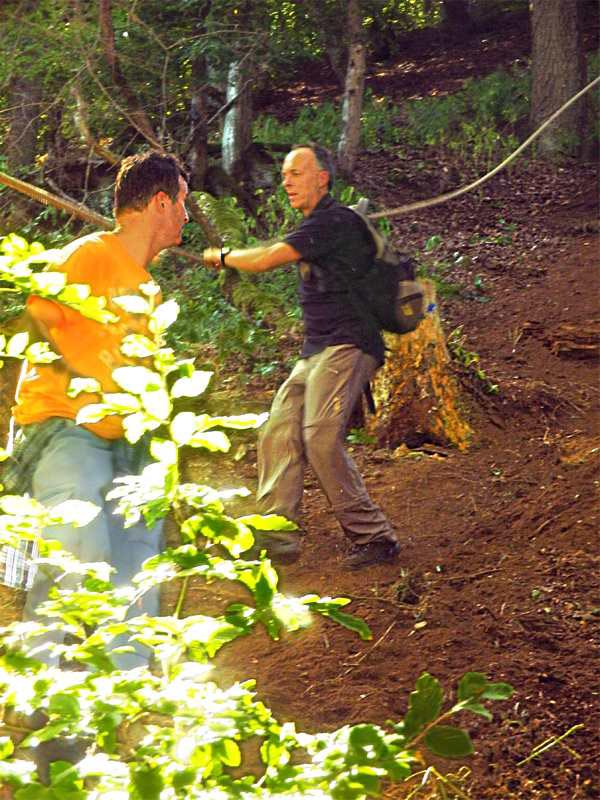
The steep descent takes you down to the wide, flat Lahn river valley.
Walk the border -- on a map, a nice straight line, isn't it?

The steep descent takes you down to the wide, flat Lahn river valley.

Spielmannzeug ("playing man [musician] parade") Stötten leads on. There are 19 men's clubs and boys fraternities -- this one will make the Day 3 entry into town in style, with horse and rider, flag carrier, and the Musikkapelle Stötten to announce their coming.
Has any marching band ever marched more than these top national ones do at Grenzgang?


Return into town on Day 2 -- proud just to be stragglers.. The guys
whose hats are above the crowd
are on horses.

The band played, we marched -- unknown to us, this article had come out
that morning in the paper, and one person called down from her window,
hey, we saw you
in the paper !!
Really, what more could you want? Worth the price of the T-shirt.
Really, what more could you want? Worth the price of the T-shirt.

THE FAIRGROUNDS & AMUSEMENT PARK
( bottom & contents )
We always got back into town around 3:30, the stragglers at the end of the line, with no time for the enormous amusement park installed on the Lahn valley meadow, featuring a beer tent and dance floor as big as any at Bavaria's Oktoberfest (thank you, Bosch Bier). The parades and events down there brought the girls out in force -- the Balbinen from Balbach, and the Hasenlauf ("rabbit run") neighborhood girls in the afternoon ( http://mg.hasenlauf.de/pfe/2012-2-grenzgangstag-nachmittag/ scroll down to photos of kids in red shirts). These are the sororities associated with the best of the Burschenschafts. Dancing went on past midnight . . . all with live bands, but not with us, and definitely not with the other bands, the marching bands that would be up at 4AM and in costume and in tune for the 6AM cannon shot, fired up to cheerfully let the rest of us know that we were already late.
CORPORATIONISM vs CIVIC SOCIETY

Left: A woman's pennant is hung on a
larger men's banner.
Right: from "The 16 Profitable Companies That Pay Almost Nothing in Taxes"
Left: The girls' and women's sororities and clubs of Biedenkopf hang their narrow, vertical pennants on the men's big banners. This Balbach Balbinen's pennant says "Der Wal iss inser ! ", or, in high German, "Der Wald ist unser", the forest is ours. The Biedenkopf Grenzgang festival has been celebrating the people's ownership of the forests around them for over 300 years.
-----=o=-----
Right: from "The 16 Profitable Companies That Pay Almost Nothing in Taxes"
Left: The girls' and women's sororities and clubs of Biedenkopf hang their narrow, vertical pennants on the men's big banners. This Balbach Balbinen's pennant says "Der Wal iss inser ! ", or, in high German, "Der Wald ist unser", the forest is ours. The Biedenkopf Grenzgang festival has been celebrating the people's ownership of the forests around them for over 300 years.
-----=o=-----
Our old neighbors in Bürgeln cared for us while we recovered before visiting friends in Frankfurt. We shared rooms in a creaky old hotel with our son and grandchildren, and then we were home again, able to do things just not possible while traveling. I love the music loud in our cathedral-ceiling living room.
"I just can't understand why nearly 400 watts of audio power can't manage to sound any better than this."
"Because you're going deaf."
With best wishes from
Robin & Jerry Nelson

Panorama: Thorsten Richter,
Oberhessische Presse, Marburg.
A WALK IN THE PARK ( bottom & contents )

top
THIS IS PAGE ONE
Introduction
The Middle Class Says "No" to the Middle Ages -- towns appear across Europe,
full of people with their own ways to make money (to create non-agricultural wealth)
Finally & Completely: the Woods are Ours -- a negotiated treaty with the emergent state powers of the times
Local nobility sniffs at the quaint habits of the commoners
Financial Bubble, Speculative Wealth, Better Things to Do
Breakfast begins at 5AM
"Kommers" -- the town is thrown open for residents and guests the evening before marching begins
All Lined Up -- organized into Mens' Neighborhood Clubs and boys neighborhood frats,
the whole town assembles on the Marktplatz as a civic force before the Mayor
Smiles Everywhere
"It is stunning -- incomprehensible -- to see thousands of happy, jolly people at 6 in the morning."
("Es ist unfassbar, tausende fröhliche Menschen morgens früh um 6 Uhr zu sehen."
-- a report to the folks back home from one of the many bands that got up at 4AM to wake the town and drive the pageantry.)
Wettläufer & Moor, the Grenzgang's top symbolic figures.
Out of the Marktplatz -- the march has begun
Behind the Scenes -- horse care, and Grenzgang organization
Neighborhood Clubs are the Civic Backbone
Bands, Bands, Bands After you bring in over 10 marching bands from as far away as Austria,
you might as well regard Grenzgang as a traditional music festival.
Deep & Quiet -- the forest was as quiet as the Marktplatz was noisy.
Frühstücksplatz -- beer and bratwurst
The March Back Down into Town
Fairgrounds and amusement park -- Why stop with Germany's best traditional marching bands?
Dance into the night on Friday and Saturday with another set of live rock bands.
Corporationism vs. Civic Society -- the corporate tax rate of 35% is way too high. But don't worry, nobody pays it.
Biedenkopfers kept their woods. Americans put theirs in private hands
("privatization" of public lands, radio spectrum, highways, infrastructure).
If the private owner pays no taxes, then the takeover is robbery.
The German woods compared to a walk in an American park
The Middle Class Says "No" to the Middle Ages -- towns appear across Europe,
full of people with their own ways to make money (to create non-agricultural wealth)
Finally & Completely: the Woods are Ours -- a negotiated treaty with the emergent state powers of the times
Local nobility sniffs at the quaint habits of the commoners
Financial Bubble, Speculative Wealth, Better Things to Do
Breakfast begins at 5AM
"Kommers" -- the town is thrown open for residents and guests the evening before marching begins
All Lined Up -- organized into Mens' Neighborhood Clubs and boys neighborhood frats,
the whole town assembles on the Marktplatz as a civic force before the Mayor
Smiles Everywhere
"It is stunning -- incomprehensible -- to see thousands of happy, jolly people at 6 in the morning."
("Es ist unfassbar, tausende fröhliche Menschen morgens früh um 6 Uhr zu sehen."
-- a report to the folks back home from one of the many bands that got up at 4AM to wake the town and drive the pageantry.)
Wettläufer & Moor, the Grenzgang's top symbolic figures.
Out of the Marktplatz -- the march has begun
Behind the Scenes -- horse care, and Grenzgang organization
Neighborhood Clubs are the Civic Backbone
Bands, Bands, Bands After you bring in over 10 marching bands from as far away as Austria,
you might as well regard Grenzgang as a traditional music festival.
Deep & Quiet -- the forest was as quiet as the Marktplatz was noisy.
Frühstücksplatz -- beer and bratwurst
The March Back Down into Town
Fairgrounds and amusement park -- Why stop with Germany's best traditional marching bands?
Dance into the night on Friday and Saturday with another set of live rock bands.
Corporationism vs. Civic Society -- the corporate tax rate of 35% is way too high. But don't worry, nobody pays it.
Biedenkopfers kept their woods. Americans put theirs in private hands
("privatization" of public lands, radio spectrum, highways, infrastructure).
If the private owner pays no taxes, then the takeover is robbery.
The German woods compared to a walk in an American park
PAGE TWO -- MAPS
PAGE THREE -- MORE OLD PHOTOS from Grenzgang 1956
home page for this small website (travel essays, mostly)
home page for my other website (technology, politics, art, literature, complaints about life, how many stamps to put on an envelope . . . )
Liebe Leute! Bitte an jerry-va at speakeasy dot net Korrektur u. Verbesserungen schreiben.
Kann jemand irgend welche Teil übersetzen? Ich könnte es vollziehen, hätte ich von anderen den Anstoß. Beihilfe kann nur an bessere, ausgebreitete Redewendung, Ausdrücke, Wortschatz hinführen.
Danke.
Rev 19Aug2016
